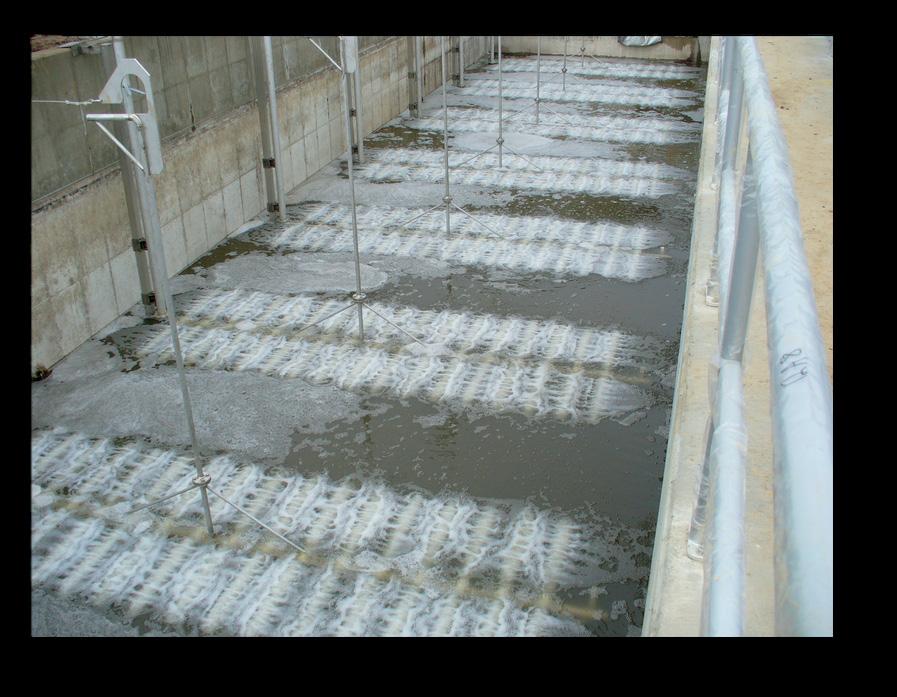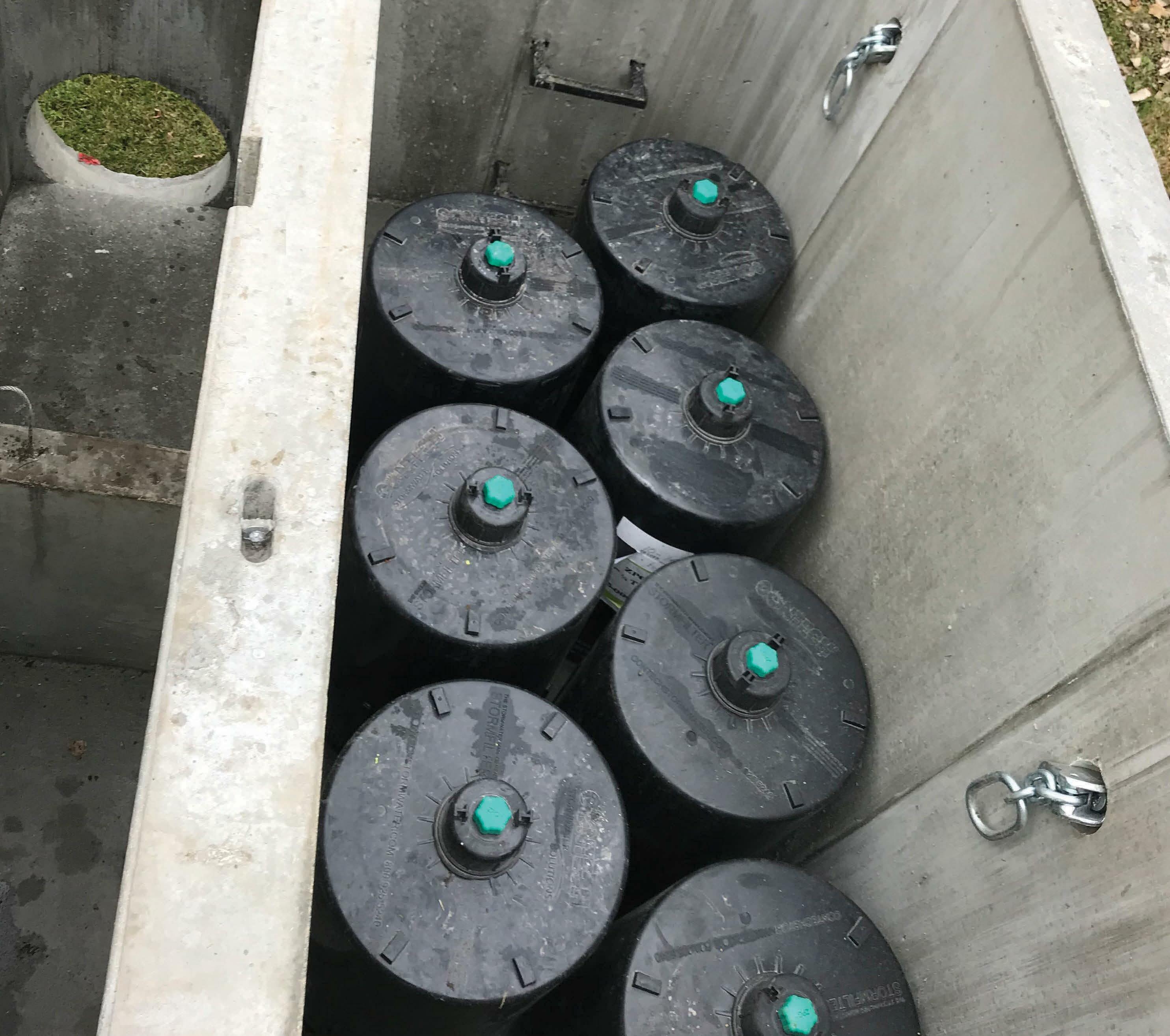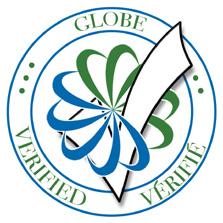






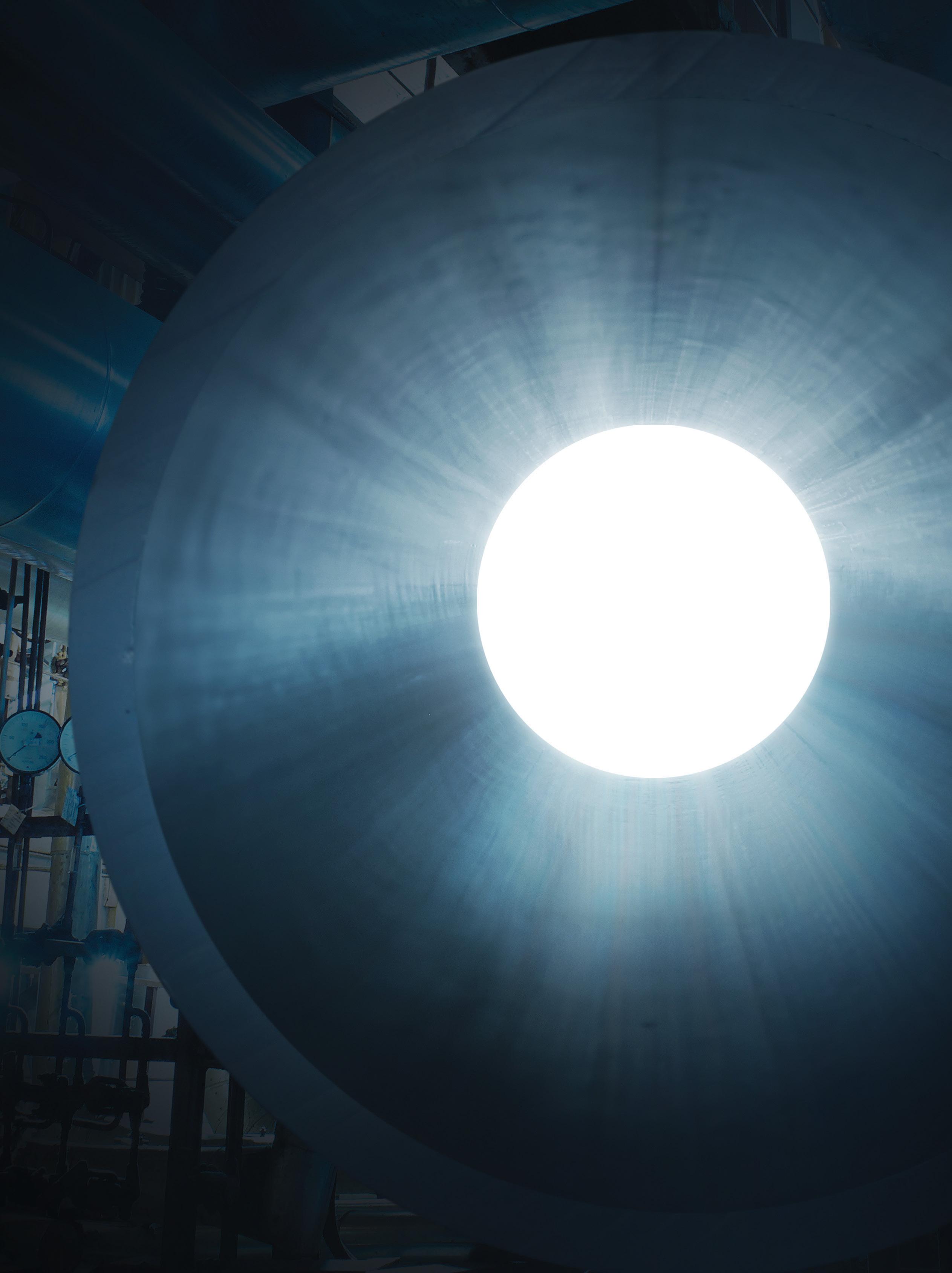

For the first time, industrial ethernet enters ABB instrumentation with the ProcessMaster and CoriolisMaster.
ABB flow measurement is connection made easy! Gain quick access to meters with a standard browser on a laptop, tablet or mobile device in parallel to PLC – secure and via the same cable. abb.com/measurement or contact us at instrumentation@ca.abb.com
Let’s

AGAWIN
GILLETT
Archis Ambulkar OCT Water Quality Academy
Gary Burrows City of London
Patrick Coleman Stantec
Bill De Angelis Metrolinx
Mohammed Elenany Urban Systems
William Fernandes City of Toronto
Marie Meunier John Meunier Inc., Québec
Tony Petrucci Black & Veatch
Science & Engineering
a bi‑monthly business publication of Environmental Science & Engineering Publications Inc. An all Canadian publication, ES&E provides authoritative editorial coverage of Canada’s municipal and industrial environmental control systems and drinking water treatment and distribution.
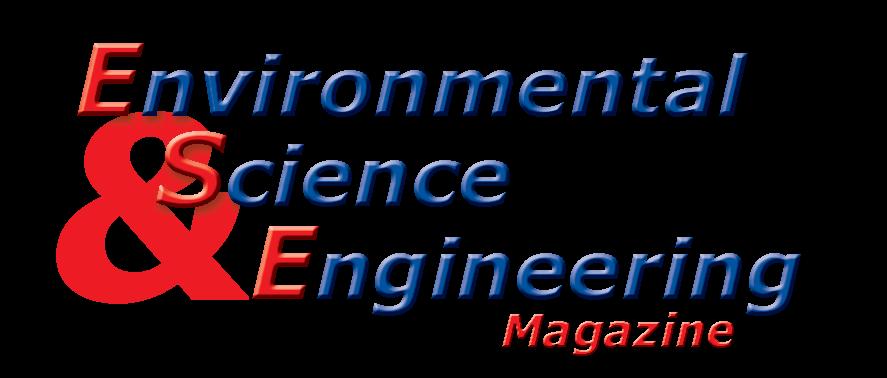
Readers include consulting engineers, industrial plant managers and engineers, key municipal, provincial and federal environmental officials, water and wastewater plant operators and contractors.
Information contained in ES&E has been compiled from sources believed to be correct. ES&E cannot be responsible for the accuracy of articles or other editorial matter. Articles in this magazine are intended to provide information rather than give legal or other professional advice.
Canadian Publications Mail Sales Second Class Mail Product Agreement No. 40065446 Registration No. 7750
Subscription Changes?
email reader subscription changes to ese@mysubscription.ca, or call 705-502-0024
Environmental Science & Engineering 220 Industrial Pkwy. S., Unit 30 Aurora, Ontario L4G 3V6 Tel: (905)727-4666


www.esemag.com
Mommas, don’t let your babies grow up to be meteorologists
Report applauds COVID-19 wastewater surveillance
Editorial Comment
CSA Group develops how-to guide for municipalities to integrate water standards
Decanters provide smooth operation for military base’s WWTP
Using cartridge filtration systems to remove PFAS contaminants from drinking water
Quebec mining firm fined $15M for Fisheries Act violations

Investigating the source and age of nitrate in drinking water wells
What is the real mixing limit for mixed liquor?
Hamilton tackles major problem caused by residential wastewater pipes mistakenly connected to storm sewers
Collingwood, New Tecumseth to update costs of pipeline drinking water agreement
Using Python can help Canadian water utilities cope with vast amounts of data
UWaterloo leads new PFAS investigation into seven Ontario water systems
Ensuring peace of mind against leaks when lining above ground storage tanks

Halifax Water uses advanced pressure management pilot to reduce leakages
Challenges, opportunities for reuse of stormwater management pond sediment
Maximizing process, energy efficiency of heat exchangers for wastewater applications
problem with PFAS waste incineration

monitoring as a community health indicator
York Region wins award for sewage forcemain upgrades using microtunnelling
Cleaning, DO Control, AlphaMeter Mixers – Anoxic & Swing Zones, Sludge Holding, Digester; Mechanical, Hydraulic and Gas Bubble
Tank Components – Covers, Fabric Ba es, Troughs, Weirs, Scum Ba es, Skimmers, Decanters, Swivel Joints, Telescoping Valves, Density Current Ba es, Launder Covers, Watertight Doors

Primar y & Secondar y, Circu r, Chain & Flight, Inclined Plate Settlers, Weir Washing
Biological – SBR, MBR, RBC, MBBR, MABR, Oxidation Ditch, BioMag, CoMag Polymer – Liquid and Dr y Systems
•
Rotary Lobe Pumps & Grinders
• Disinfection UV, Ozone


• Tertiary Filters Travelling Bridge, Disk, Membrane
• Sludge Thickening & Dewatering Disk Thickener, Gravity Thickener, Filter Press, Screw Press, Centrifuge

• Anaerobic Digesters – Sludge Condi tioning, In line Screening, Degritting, Membrane Gas Holders, Liquid Mixing, Nutrient Recover y

• Sludge Drying – Belt, Fluid Bed and Solar
• Septage Receiving – Screens, Dump Stations, Truck Access & ID, data gather ing & equipment control
Sludge Treatment, Transport & Stor age

Cake Pumps, Silos, Sliding Frames, Live Bottom Hoppers, Push Floors, Truck Loading, Alkaline Stabilization
Odour Control – Tank Covers, Chemical & Biological Treatment, Activated Carbon
StationsPump&StormwaterCSO, Tipping Buckets, Bending Weirs, Flushing Gates, Flow Regulating, Vor tex Valves, Storm Screens




Digester Gas Gas Holders, Gas Condi tioning: chilling; compressing; and remov al of moisture, sulphur, carbon dioxide and siloxane, complete Co Generation facilities

Despite the title of this piece, let me set the record straight; I have noth ing against meteorologists. I know some, they’re nice people, about 60% of the time.
I mean, where else can you work and be correct 60% of the time and still have a job?
But I do feel badly for people in that profession because, after government workers and politicians, they get blamed for all the horrible weather evils that come our way.
Weather records throughout the world that have been around for a long, long time, are being smashed on a reg ular basis and the pace doesn’t appear to be slowing down. Many countries around the world, including Canada, Australia, the U.S. and Europe have all experienced extreme weather events that are pushing boundaries and resources to the brink.
There is no country on Earth that has not felt the effects of climate change to some degree. The worldwide climate-re lated mortality rate is increasing, pri marily in areas where the most vul nerable live. Each passing summer day brings more extreme thunderstorm and heat warnings.
In the meantime, climate modelling predictions from numerous high-level institutions disagree with each other on what’s happening, or what’s in store for us in the future. The next 20 or so years will prove whose model was right. For now, much of humanity must find ways to adapt to the ever changing and ever unpredictable weather extremes that are being seen around the globe.
For decades, the “hundred-year-storm” has been used as the benchmark for weather events. What it means, in effect, is that you should expect a storm of a particular intensity every 100 years or so.
However, just in Southern Ontario, over the last 20 years, there have been
It’s always been tough to be a farmer; climate change is just making it all the tougher.

five or more breaches of the hun dred-year benchmark for rainfall alone. That, too, tells us that the weather par adigm has shifted dramatically, and in less than 100 years. When it comes to weather today, we often find ourselves in uncharted territory, and things are very uncertain.
The new “tornado alley” in Canada is now the Barrie/Ottawa/Gatineau area.
During the last 50 years, tornadoes in this area have resulted in widespread property damage and many fatalities. In general, storms everywhere are becom ing more intense due to the excessive amount of energy released from over heated, moist air as it is cooled, even slightly.
During all stages of history, the collection of weather data has been extremely important. The collection of weather observations is critical in that it helps us identify changes and through those changes, hopefully patterns will emerge. It takes years to establish reli
able patterns, but the last 50 years’ worth of data has revealed distinct increases in air, land and sea temperatures around the world. The scientific world has embraced this reality and is trying its best to understand where it is taking us. Climate change deniers now exist pri marily in the conspiracy theory camps.
One of the most concerning changes that has been observed with increased global temperatures is increased drought. This not only affects food and livestock crops, but also causes extremely dry conditions in our forested areas. Dry forests are easily ignited by lightning strikes, which are also increasing glob ally due to more intense thunderstorms created by excessive heat. Hot air con tains immense amounts of energy and when that energy is released it can be catastrophic at times.
The main debate now is whether or not humanity can halt or even roll back the damage caused by CO2 emit continued overleaf…
Credit: Budimir Jevtic, stock.adobe.com
ted through the burning of fossil fuels. Nobody knows for sure if we are reach ing the “point-of-no-return”, or whether we’ve already passed it.
As we learn through our experiences, it turns out that carbon dioxide may not be our biggest concern, but it certainly plays a major role it what is happen ing. Science has been telling us (for a long time) that carbon dioxide is what is causing the “greenhouse effect”. Car bon dioxide is causing the atmosphere to heat up beyond what it would if levels were lower.
The trapped heat is having profound effects on global water resources, due to elevated evaporation rates from the surface of the Earth and bodies of water. Hotter air is able to hold more moisture and when it is released it is often in a violent form.
Hurricanes are getting more frequent and more intense, likewise for torna does. Droughts are lasting longer, lakes are drying up, the Arctic and Antarc tic poles are melting at an alarming rate. Yet, only a small percentage of the global population are committed to greening their lifestyles. The rest are clinging to the fossil fuel economy, which many people feel has been the root cause of the current climate problem.
Often forgotten is the fact that, throughout the Earth’s 4.5-billion-year history, the climate has always been changing. Five planetary ice ages tell us that. The last ice age lasted two and a half million years and only left us 12,000 years ago.
Ice core samples also tell us that car bon dioxide levels on the planet have been as high as 4,000 ppm (parts per million) during the Cambrian period, 500 million years ago. During the Qua ternary glaciation period, two million years ago, levels were as low as 180 ppm, which coincides with the lower plane tary vegetation level due to the ice age.
Global CO2 levels in 2022 are in the range of 415 ppm.
Much speculation is put into trying to understand how organic life adapted during those prehistoric conditions. The clues are few, and tough to find.
When it comes to forest fires, we are seeing fires like we have never seen before. The epic Australian fires recently
burned over 12 million acres of land and killed over a billion animals. Many of the animals that perished were domes tic animals and more than 2,000 homes were destroyed. Thirty people died, some of whom were firefighters.
The summer of 2022 saw the Yukon and Northwest Territories fighting mega fires that resulted in many evacuation orders and relocations, largely affect ing First Nations people. This came on the heels of two consecutive winters of near record snowfalls, followed by two consecutive springs of record flood ing, especially in the lower-lakes region south of Whitehorse.
The Arctic and sub-Arctic areas are warming at more than twice the rate in the south. This warming is causing per
derstorm warning where some areas received up to 100 mm of rain within a matter of a few hours.
This type of precipitation benefits farmers very little as it tends to run off to the nearest river or lake without hav ing the chance to soak into the ground properly. Torrential rainfalls can also cause fields to be torn up by water as it rushes toward ditches, resulting in fur ther crop loss. It’s always been tough to be a farmer; climate change is just mak ing it all the tougher.
Right now, there are more questions than answers. Are we moving toward greening our energy supply quickly enough? Are we moving too slowly to rid ourselves of our dependency on fossil fuels? Is nuclear energy going to
Often forgotten is the fact that, throughout the Earth’s 4.5-billion-year history, the climate has always been changing. Five planetary ice ages tell us that. The last ice age lasted two and a half million years and only left us 12,000 years ago.
mafrost to melt, which in turn is releas ing methane gas that has been trapped in the frozen ground for millennia. When it comes to greenhouse gasses, methane is 84 times more damaging than carbon dioxide. Increased methane in the atmo sphere is dramatically enhancing the greenhouse effect, and more permafrost is melting all the time.
The summer of 2022 in southern Ontario also saw extremely low precip itation rates in most areas. Coupled with several days well in to the mid 30s, some farmers saw an 80% decrease in yield for many of their crops. Earle and Sha ron Clugston, who have owned Shearlea Acres in Lynden, Ontario, since the early 1970s, advised me that lettuce and cucumbers were particularly hard hit along with sweet corn and other waterthirsty vegetables.
When it did rain, which was seldom, it was generally under a severe thun
make a big comeback? Is there going to be a solid path forward or will changes in world governments constantly plague progress?
But the biggest question of all is: Are we making the right choices and are we making them in time?
We have a lot of great minds work ing on solutions and I think they need to hear our cries of support and not our cries of indignation. Their job is not an easy one.
So, mommas, don’t let your babies grow up to be meteorologists. Let them grow up to be scientists, so we can all work toward a permanent climate change solution that will benefit man kind into the future and beyond.
John Smythe is with NOVA Training and Development Inc. Email: contact@nova-td.net

 By ES&E Staff
By ES&E Staff

Anew report from the Royal Soci ety of Canada (RSC) makes a series of recommendations based on expert analysis and lessons learned from wastewater surveillance during the COVID-19 pandemic, which had caused some 6.4 million deaths worldwide, as of the end of July 2022.
The report views wastewater surveil lance as an objective and independent window that provided a valuable dataset on the persistence of COVID-19 infec tion as indicated by virus-shedding in the population through faeces.
One of the keys that made wastewater surveillance of SARS-CoV-2 RNA effec tive, the RSC found, was the level of col laboration among public health agencies, local wastewater treatment plant opera tors, and academic research laboratories.

“Many public health officials were initially skeptical about whether or not actionable information could be pro vided by wastewater surveillance for SARS-CoV-2,” states the RSC report. “However, previous experience has shown that public health surveillance for a pandemic has no single, perfect, all-purpose tool to characterize all the important features of what is happening in a timely manner,” the report adds.
The report views wastewater surveillance as an objective and independent window that provided a valuable dataset on the persistence of COVID-19 infection. Credit: Felipe Caparrós, stock.adobe.com
Ultimately, organizations such as the Public Health Agency of Canada, the World Health Organization, as well as the European Commission and the U.S. Centers for Disease Control and Preven tion, recognized wastewater surveillance as an important tool in the pandemic.
The wastewater surveillance option also provided a much less expensive option on a per capita basis than other testing methods, the report states, par ticularly as clinical testing was over whelmed in the face of variants, such as Omicron.

Although initial emphasis was on mon
itoring at WWTPs serving large commu nities, researchers successfully monitored sewers directly serving priority locations such as long-term care facilities, hospitals, university residences, as well as industrial and correctional facilities.
Wastewater surveillance was also use ful in capturing signals from asymptom atic individuals, the report states.

In April 2020, RSC established a task force to equip Canadians with accurate information about the country’s response and recovery to COVID-19.
Some of the key recommendations made in the report include the need to create structures and capacity to sustain capability and develop rapid response to future public health threats, as well as to build upon existing infrastructure and programs.
In addition to designing frameworks for surveillance programs, the report also recommends new frameworks for interpretation of the data. Maintaining and promoting academic partnerships and communication networks that will help identify new opportunities and threats is also considered a priority.
For more information, email: editor@esemag.com
Standards development organiza tion CSA Group has published a municipal how-to guide for local officials to maintain high commu nity water standards in the face of grow ing threats from climate change.
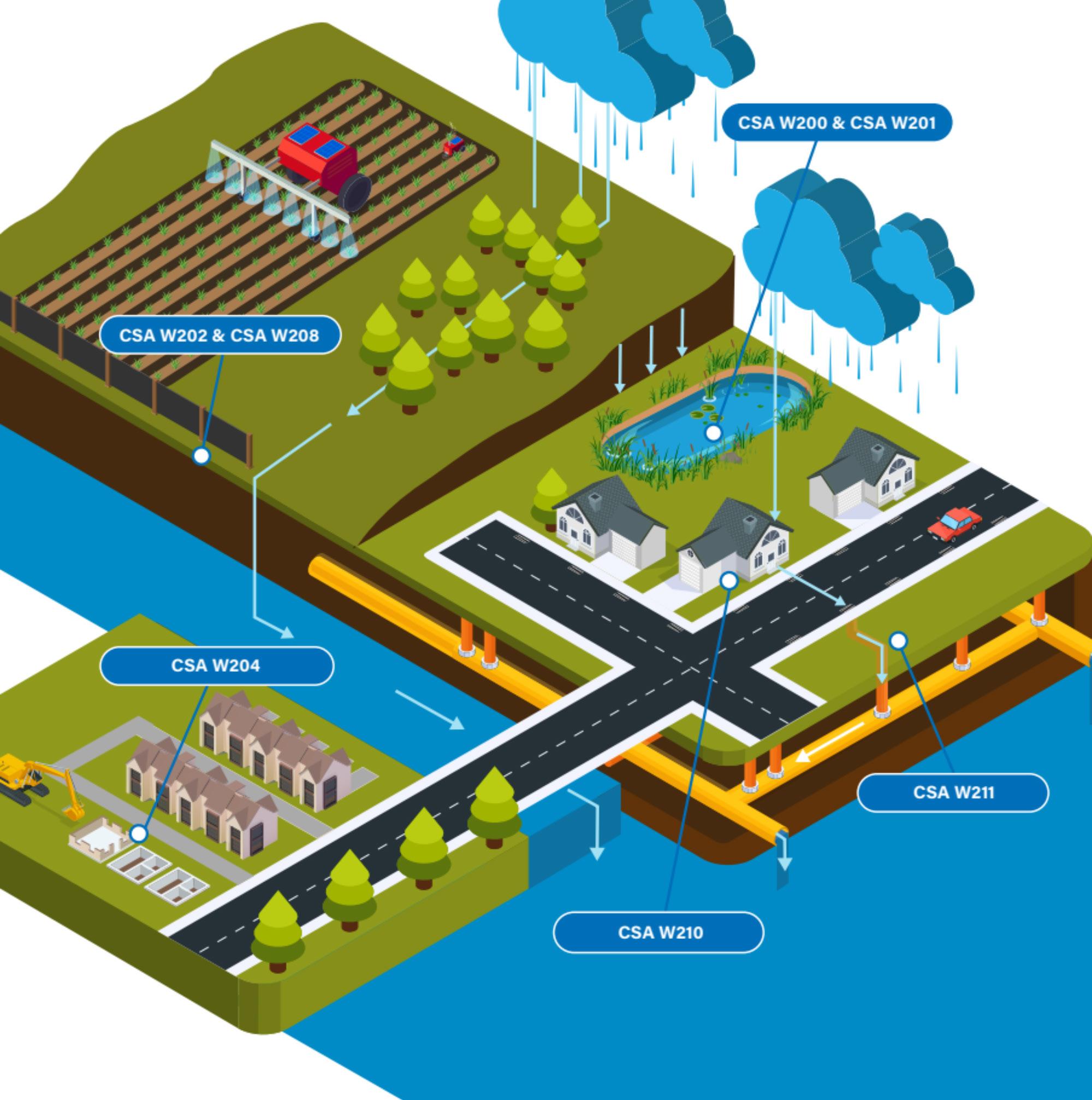
CSA says that municipalities “shoul der the burden of responding to these events and their aftermath,” and need help. Focusing on flood resiliency, storm water, bioretention systems, as well as erosion and sediment control, the new guide highlights a three-step process to integrate CSA standards into municipal planning.
“Our ultimate goal is to have networks of resilient communities supporting each other,” announced Michael Leering, director of environment and business excellence at CSA Group, in a statement. “For a municipality to truly be resilient, their neighbouring municipalities must also be working towards the same goals and implementing the same standards,” he added.
In step one, the CSA guide recom mends that municipalities assemble a “toolbox” that takes stock of elements already in place, such as existing munic ipal bylaws and other strategic docu ments. The guide suggests taking advan tage of established CSA standards for stormwater management), bioreten tion system design, and flood resilience design, to name just a few.
CSA views step two as finding gaps where new tools in the toolbox, or stan dards, can be implemented. This can come through the municipality’s leaders answering a series of questions. Exam ples of these could be: Does your munic ipal zoning bylaw or land use bylaw limit development in areas subject to flood ing? Does your municipality’s storm water management plan encourage low-impact development and/or green infrastructure for stormwater manage ment? Or, does your municipality (or conservation authority) require devel
opers to prepare and submit an erosion and sediment control plan? The guide then links local officials to the relevant CSA standard when answering these types of questions.
The third and final step recommended by the new guide is for municipalities to integrate these standards by reference into existing policies and guidelines or develop new ones. For instance, the CSA Community Water standards can be implemented under community plans, zoning bylaws, subdivision agreements, and many more.
The guide also suggests ways to imple ment certain requirements, such as bio retention standards, directly into new contracts and requests for proposals.
To develop the guide as a resource for
urban planners, managers, and elected municipal officials, CSA collaborated with four Canadian municipalities impacted by flooding in recent years: Colwood, Brit ish Columbia; High River, Alberta; Lake shore, Ontario; and Cambridge, Ontario.
“The launch of a guide to support municipal uptake of CSA Group stan dards provides an important tool for interpretation and decision making,” announced Lisa Prime, chief planner for the City of Cambridge, in a statement. “Municipalities can benefit from further opportunities to meet technical perfor mance requirements for development through standards,” she added.
For more information, email: editor@esemag.com
A graphic from the new how-to guide for local officials illustrates how CSA Group Community Water Standards can be integrated into the municipal planning process. Illustration: CSA Group






In 2014, the Northern Wastewater Treat ment Plant of Marine Corps Training Base Camp Pendleton in Southern California, was designed with purpose and efficiency in mind for its migra tory population of around 200,000 peo ple, which includes 18,000 troops, plus employees and their families. The $66 million plant was built to consolidate all the pump stations and lift stations of 12 treatment plants down to just the North ern and Southern Treatment Plants, cov ering some 85,000 hectares.
While the Southern plant kept its older equipment, the Northern plant was outfitted with new Flottweg centri fuge decanters and 3.2 megawatts of solar power. The base supplies the power, but the solar power feeds the facility. Excess power returns to the base’s grid. There is a 2,000 kW generator for backup. The plant produces a megawatt of produced power every two to three days that returns to the main grid at the base.
The centrifuge runs once or twice a month on average, according to Chief Plant Operator Phil Starks. “At times the centrifuge must be used multiple times a week,” he said. “Digestion is over 200 days sludge retention time (SRT) with good sludge concentrations. We have excellent aerobic sludge digestion avail able with a lot of volume reduction and two extremely large digesters. One is kept about half full at all times. When the level gets high, the decanters are run to bring the level back down.”
With constant sunshine, the plant is able to spread out the solids to naturally dry them. The primary goal for the oper ation of the centrifuges is not for the percentage of solids produced. Instead, the focus is on the centrate going back to the plant. “I want the cleanest centrate possible because neither drying nor vol ume is an issue,” Starks explained.
“We have absolutely no problems with the centrifuges. The only issue has been
an experiment to see how the centrifuge would react to a thicker solid coming in from the digester. It operated great, but we didn’t flush the unit appropriately with the thicker solids, causing just a few minor adjustments.”
Clean water is becoming an increas ingly valuable raw material, which is why the importance of municipal waste water treatment continues to grow. Slud ges resulting from drinking water and wastewater treatment must be separated as efficiently as possible. For the dewa tering and thickening of sewage sludge, industrial centrifuges are now consid ered the state of the art. They are cost-ef fective, energy-saving, and efficient.
The most important goal in dewa tering is to maximize the reduction of the volume of sewage sludge. The rea son for this is that every tenth of a per cent increase in dry solids in the sludge reduces the costs of sludge disposal. The dewatering decanters of the Flottweg

C-series and X-series reduce operat ing costs and energy consumption and achieve a higher dry solids content.

During thickening, a high degree of separation and a low polymer con sumption are extremely important. Both relieve the burden on subsequent pro cesses and improve the overall perfor mance of the wastewater treatment plant.
A decanter can be regarded as a sed imentation tank that is wound around an axis. In the sedimentation tank, the solid particles, which are heavier than the liquid, move to the bottom by grav ity and form a sediment (solid phase) at the bottom of the tank. For example, a wine decanter can be understood as a kind of sediment vessel. In a centrifuge, the solid and liquid phases are separated by means of centrifugal acceleration.
In the rotating bowl of the centrifuge, the solid particles, which have a higher density and are therefore heavier than continued overleaf…
The Northern plant was outfitted with new Flottweg centrifuge decanters.






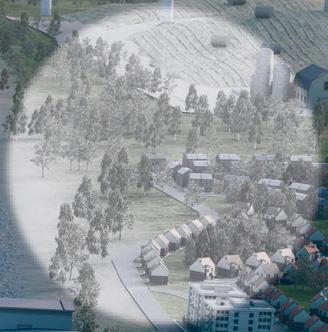













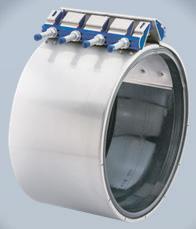





















the liquid, move outward because of cen trifugal force. Sediment is formed on the inner wall of the centrifuge bowl. Since centrifugal forces of approximately 3000 g are exerted in a centrifuge as opposed to 1 g in a gravitational field, the separa tion of the solid particles from the liquid is much faster and more efficient.
Product is fed into the inlet chamber of the decanter scroll through the cen trally arranged feed pipe. From there, after gentle pre-acceleration, it passes through the distributor openings into the decanter bowl.
The decanter bowl has a cylindrical/ conical shape and rotates at a pre-set speed optimally adjusted to the appli cation. The slurry rotates within the bowl at the operating speed and forms a cylindrical layer at the bowl wall. Due to the higher density, the solids contained in the product settle on the inner wall of the bowl under the action of centrifugal force. The length of the cylindrical bowl section and the cone angle are selected to meet the specific requirements of an application.
The decanter scroll rotates at a slightly different speed than the bowl and con veys the separated solids toward the conical end of the bowl. This differen tial speed determines the residence time of the solids in the decanter bowl. Res idence time is a critical factor for cake dryness. It can be adjusted by changing the differential speed of the scroll, and therefore providing optimal separation. Depending on the application and task, the scrolls are designed differently.
Settled solids are ejected through ports at the conical end of the bowl into the solids housing and fall through the discharge chute.

The clarified liquids (fluid phase) flow to the cylindrical end of the bowl where they exit over weir plates. In these open ings there are very precisely adjustable weir plates (overflow weirs) with which the pond depth (liquid layer) in the bowl is adjusted. The liquid is collected in the drain housing and discharged without pressure.
As an alternative to the overflow weir, the clarified liquid can also be dis charged via an impeller and discharged from the bowl under pressure in a closed system. This eliminates the need
The decanter scroll rotates at a slightly different speed than the bowl and conveys the separated solids toward the conical end of the bowl.
for a separate chamber pump. A further developed variant, the adjustable impel ler, allows infinitely variable adjustment of the pond depth during the run. This allows a fast and fine adjustment to changed conditions without having to take the centrifuge out of operation.
At the Northern Camp Pendleton Plant, Starks said the centrifuge works smoothly and requires little maintenance. “It’s doing exactly what it’s intended to do,” he said. “The equipment operates with little to no issues. It takes about 30 min utes to an hour for the unit to settle into a nice rhythm after a few adjustments are made with the variables like tem perature and solids concentration.
“A centrifuge is like a moving dart board. It is three dimensional, and you’re always trying to hit that exact right spot. It takes experience, combined with high quality equipment. As long as every thing is set with the variables, these units just have to start up, and then we really don’t have to do much.”
According to Starks the sophisticated decanters have many features that make finding that sweet spot easier. “Instru mentation is key and getting the feed back on the screens is essential,” he explained. “I control the unit by scroll torque. It also has differential controls, but I don’t need to use them as much. The scroll torque is much more respon sive. I can also make adjustments with the feed rate of the polymer. There are so many adjustable parameters, you could
over adjust if you’re not patient. It’s important to make one adjustment and then give it 15 or 20 minutes and then check on it. Then you can make another adjustment from that point.”
With a small staff, Starks said another advantage is that one person can eas ily operate the equipment and little to no maintenance is required. “Having maintenance free separation is just the best thing for a plant like this,” Starks explained. “You don’t want to contin uously have to take things apart and fix them. The Southern Plant is con stantly having issues because it was not designed with purpose. This is actually a very boring plant. The plant just runs so well, we rarely ever have any issues. Sometimes we are running so smoothly, we can help out at the Southern half.”
The Northern Plant is designed to handle a much larger population and this could double or even triple easily in the future without breaking capacity.
Daniel Lakovic is with Flottweg Separation Technology. Email: dlakovic@flottweg.net




 By Cyndi Benson and Alfredo Rizo-Patron
By Cyndi Benson and Alfredo Rizo-Patron
End user households and municipal water utilities are increasingly grappling with the need to address perand polyfluoroalkyl substances (PFAS) once they are detected in source water. Also known as forever chem icals, because they are among the most persistent toxic com pounds in existence, even low doses of PFAS have been linked to serious health problems.
Because drinking water standards are a moving target, while treatment options are limited and can represent a mas sive expense, addressing PFAS can be especially challenging for small water systems such as housing communities and single-family homes. The key to finding an optimal solution requires a thorough investigation of solutions.
High-pressure membranes, such as nanofiltration or reverse osmosis (RO), have been extremely effective at remov ing PFAS. Research shows that these types of membranes are typically more than 90% effective at removing a wide range of PFAS, including shorter chain PFAS.
While RO is highly effective, it comes with steep capital and operating costs, which include the handling of the contami nated waste stream.
Another treatment option is anion exchange treatment, or resins. Ion exchange resins are made up of highly porous, polymeric material that is acid, base, and water insoluble. One benefit of this treatment technology is that there is no need for resin regeneration, so there is no contaminant waste stream to handle, treat or dispose of. However, it is still not the most economical solution in many cases.
Granular activated carbon (GAC) can be the most economi cal solution for PFAS treatment in individual applications and smaller utilities. This includes the use of carbon-bedded sys tems and carbon cartridges, each of which fit inside a larger cell. GAC is a filtration media that is not selective for only PFAS, meaning that other organic contaminants in the water will also be removed.
Determining the most efficient and cost-effective GAC sys tem requires further investigation into specific applications. One example is the Harmsco WaterGuard Filtration System which combines activated carbon, cartridge filtration ultra violet neutralization, and patented “up-flow” technology in a compact filter housing design. Its large carbon block cartridge is significant because the larger surface area promotes longer contact times. The up-flow feature allows self-purging to elim inate entrapped air. Additionally, the WaterGuard offers quick filter changeout times and a self-purging design.
One small public water utility that currently follows a PFAS
Harmsco water filtration systems combine activated carbon, cartridge filtration ultraviolet neutralization, and patented “up-flow” technology in a compact filter housing design.
standard of 13 ng/L, detected elevated PFOA and PFAS con centrations in one of its wells (average combined PFOA and PFAS concentrations were approximately 37.5 ng/L).
Because the utility has had extensive experience with car tridge filtration for the removal of iron and manganese par ticulates, it began pilot testing the Harmsco activated carbon cartridge filter for PFOA and PFOS treatment. The goal was to determine its efficacy in applications throughout its ser vice area.
The pilot consisted of two parallel cartridge filters, with an average flow rate of 113.5 litres per minute total. Sampling included raw, entry point, and pre/post-filter changeouts. A removal rate of 65.3% was required to comply with internal proposed standards. Results of the pilot are expected soon.
Because of its effectiveness at a lower cost, private homes and other utilities may find cartridge filtration a viable option to address PFAS in similar circumstances.
Cyndi Benson and Alfredo Rizo-Patron are with Harmsco Inc. For more information, email: sales@harmsco.com, or visit: www.harmsco.com

Quebec-based iron ore mining com pany ArcelorMittal Canada Inc. has been fined nearly $15 million for 93 offences related to conceal ing the extent of toxic substances that entered waters near the Moisie River after a dike rupture.
The 2012 incident where the depos its took place involved lakes Saint-Ange and Webb and their tributaries which flow into the Moisie River, a proposed aquatic reserve and one of the biggest Atlantic salmon rivers in North America. Investigating the impact of the depos its from the dike breach, Environment and Climate Change Canada (ECCC) officials said that they were left with an “inaccurate and altered overview of the situation,” as the mining company made false and misleading statements to the environment officers, in violation of subsection 63(1) of the Fisheries Act.
ArcelorMittal Canada, the Canadian subsidiary of the Luxembourg-based steel giant, had been found guilty in late 2021, but appealed the decision. Ulti mately, the court upheld that Arcelor

A 2012 dike rupture led to deposits in the SaintAnge and Webb tributaries, which flow into Quebec’s Moisie River, pictured. Credit: Lkovac, Wikimedia Commons

Mittal Canada Inc. was found guilty of 93 charges and numbered company partner 7623704 Canada Inc. was found guilty of five charges for violating the Fisheries Act and Metal Mining Effluent Regulations (MMER).

According to ECCC, the inves tigation took place at the company’s Mont-Wright mining complex in Fer mont, Quebec, which opened in 1974. It
uncovered 33 unauthorized deposits out of the normal course of events of toxic substances made in water frequented by fish between May 25, 2011 and May 14, 2013, in violation of subsection 36(3) of the Fisheries Act. The criminal investiga tion resulted in the filing of charges on July 19, 2017.
Environment officials stated that they used Daphnia magna, a small freshwa ter crustacean of the suborder Cladoc era, as a test organism to determine the impacts of the lubricant oil. According to a statement by ECCC: “These water fleas are sensitive to a broad range of aquatic contaminants and are used in many countries to test toxicity.”

ArcelorMittal Canada Inc. and 7623704 Canada Inc. were also found guilty of failing to conduct the testing required during deposits out of the nor mal course of events. The firms violated paragraph 14(1)(b) and subsection 17(1) of the MMER. In addition, ArcelorMit tal Canada Inc. was found guilty of fail ing to submit quarterly effluent mon itoring reports within the prescribed time frame, in violation of subsection 21(1) of the MMER. Both companies have been added to the Environmental Offenders Registry.
For more information, email: editor@esemag.com

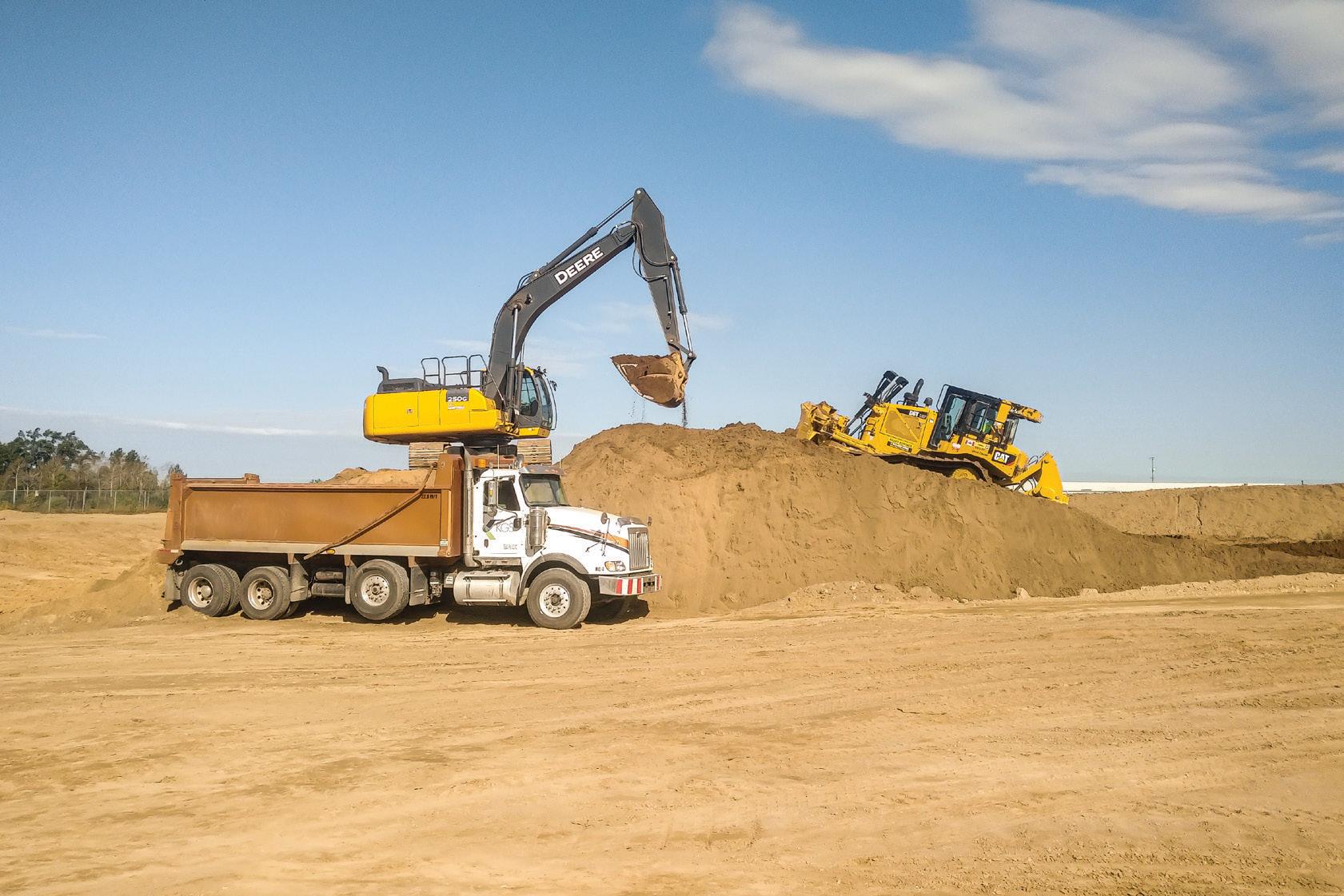


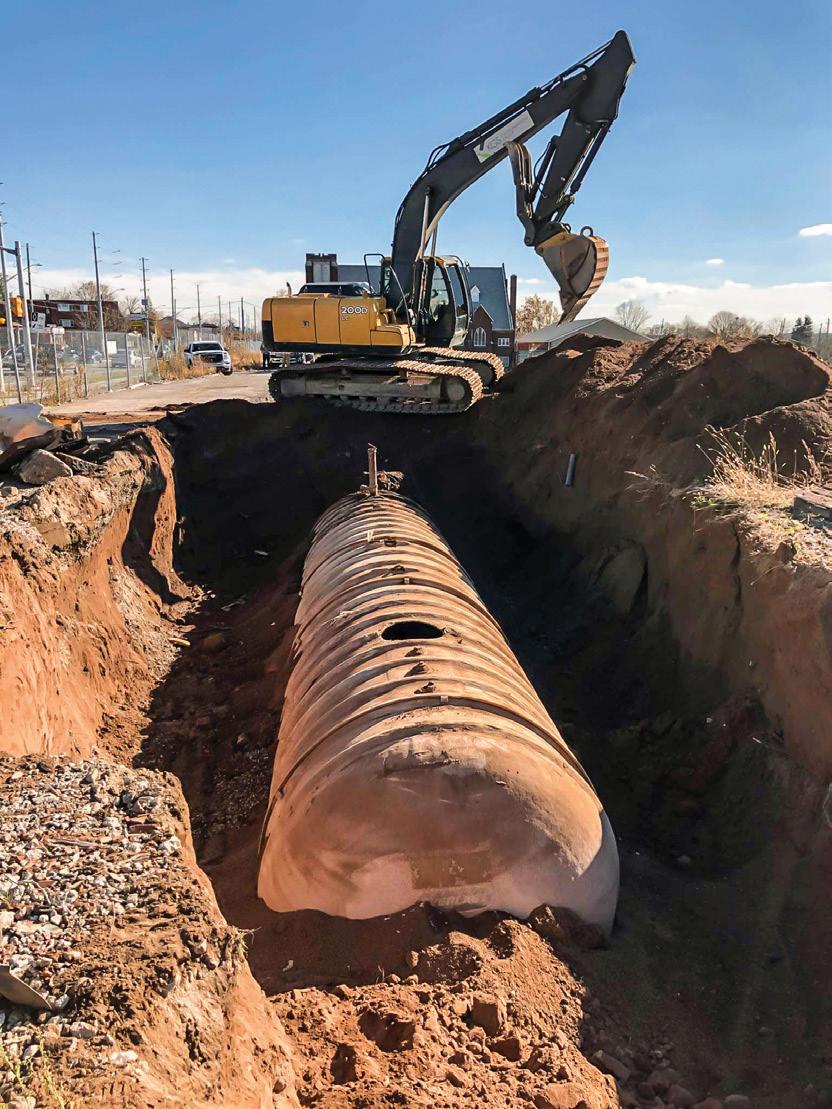
In the April 2019 issue of Environmental Science & Engineering Magazine, we published an article titled “Environ mental Isotopes Help Solve Ground water Issues” (Vakili and Sklash, 2019).
In it, we explained that environmen tal isotopes are naturally-occurring iso topes (versions of atoms) that we can use to help solve groundwater problems. The controlling factors for environmental isotopes in the hydrosphere are different from the typical groundwater investiga tion methods, which employ concepts like Darcy’s Law and groundwater flow directions and/or the interpreting dis tributions of chemicals in groundwater. Therefore, the addition of environmen
tal isotope data helps to build a more defendable conclusion than using tradi tional methods by themselves. In some cases, environmental isotopes can pro vide insight into hydrogeological prob lems without resorting to the expense of installing monitoring wells (e.g., Sklash and Mwangi, 1991).
In Vakili and Sklash (2019), we dis cussed the application of four environ mental isotopes: oxygen-18 (18O), deu terium (2H), tritium (3H), and nitro gen-15 (15N) to help understand ground water recharge, nitrate distributions in groundwater, and nitrate sources at a commercial dairy. In this article, we have summarized a recent preliminary
isotopic investigation we conducted on the source(s) and age of nitrate in groundwater in drinking water wells in a small community.
The ratios of heavy to light stable iso topes of hydrogen (2H/1H) and oxygen (18O/16O) in water molecules are largely controlled by temperature. Concentra tions of 18O (oxygen-18) and 2H (deute rium) are measured in specialized labo ratories using mass spectrometers. Con centrations of 18O and 2H are expressed in standard delta notation (δ) of the ratio of the heavy isotope to light isotope in a water sample compared to a standard water. For example, the concentration of oxygen-18 in a water sample is expressed as:
δ18O = [ {(18Osample/16Osample) –(18Ostandard/16Ostandard)}/ (18Ostan dard/16Ostandard)] x 1000 ‰
where: “δ” is read as “delta” or “del,” the standard is “SMOW” (standard mean ocean water) and “‰” means parts per mille (or mil). δ2H is deter mined similarly comparing ratios of 2H/1H. δ18O and δ2H analyses cost about $50.00 for the pair, which can be used for the following:
• Identify the age of groundwater (recent or glacial age).
• Identify recharge mechanisms (direct infiltration versus infiltration of evapo rated water from ponds, infiltration of ponded water into groundwater, etc.).
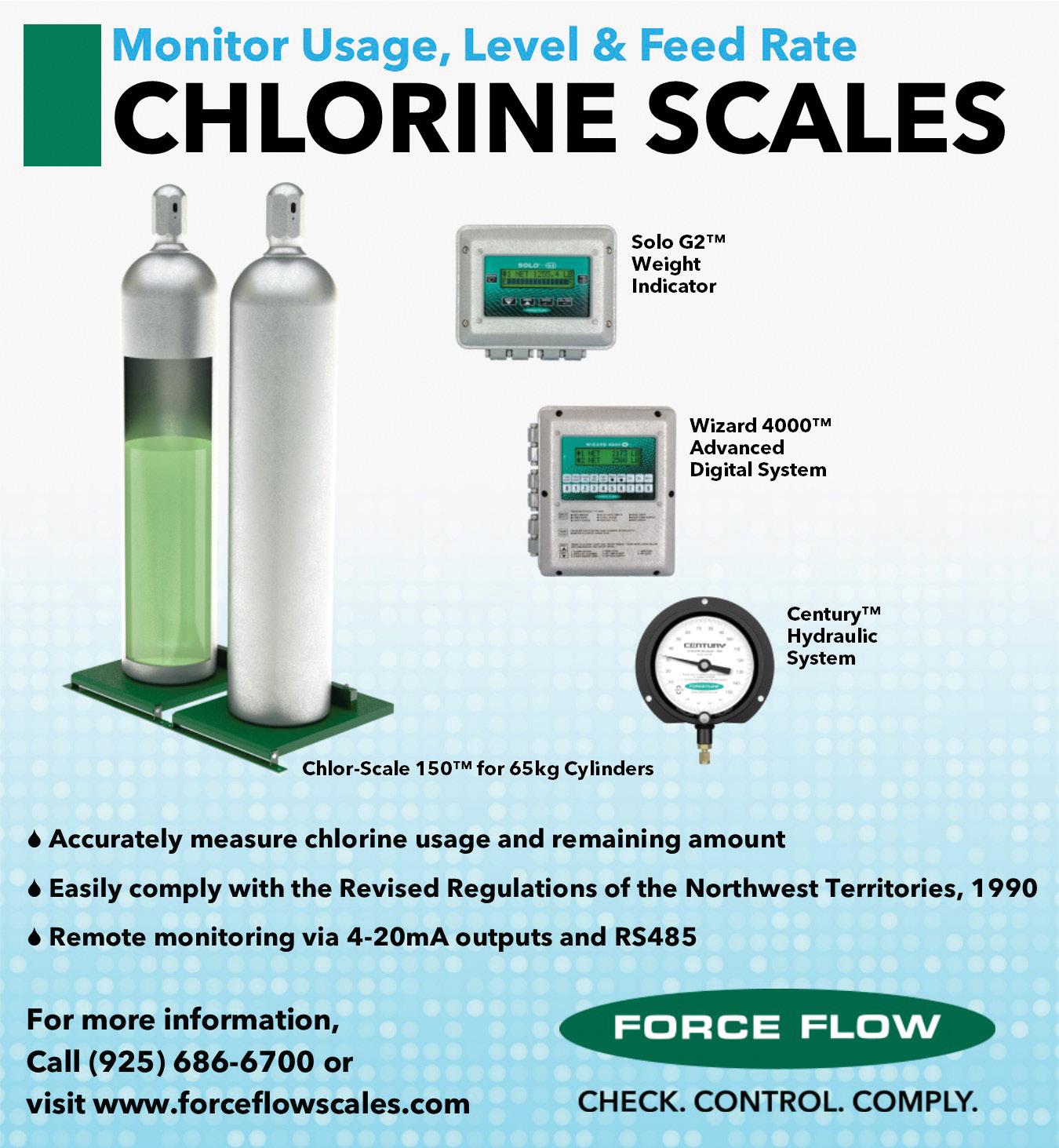
• Identify whether mixing of ground water occurs in, or between, aquifers.
• Determine travel time through thick aquitards.
• Determine the percentage of current rainfall in storm runoff in a stream.
Tritium (3H) is a radiogenic isotope of hydrogen, whose concentration in groundwater depends on when the groundwater was recharged. Concen trations of tritium are measured in spe
cialized laboratories using scintillation counters. Concentrations of tritium are expressed in tritium units (TU) where 1 TU means one tritium atom in 1018 pro tium (1H) atoms. 3H analyses cost about $200. The basis for tritium aging of groundwater is:
• Groundwater takes on the tritium concentration of the precipitation that recharges groundwater.

• Before and during the early 1950s, nat ural tritium concentrations in precipita tion were thought to be 10-25 TU (there were few measurements at that time).
• During the 1950s and early 1960s, tri tium concentrations in precipitation increased greatly (to 1000s of TU) due to atmospheric testing of nuclear bombs; the explosions created “bomb tritium.”
• In 1963, the USSR and the USA signed an atmospheric test ban treaty. Subse quently “bomb tritium” in precipitation was greatly reduced.
• Tritium is a radiogenic isotope with a half-life of about 12.3 years. This means that the concentration of tritium spon taneously is reduced by half about every 12.3 years.
• After 1963, the tritium concentrations in precipitation gradually diminished.
• Recent precipitation in the temperate areas of North America contains about 10 TU of tritium.
As a result of these factors and assum ing no mixing in the groundwater flow system following recharge (that would mix the tritium concentration of the groundwater), groundwater recharged in, or before, the early 1950s now con tains less than 1 TU. Groundwater recharged in about 1963 would now con tain about 90-100 TU, and so on.
During the past several decades, iso tope hydrogeologists have used the ratios of 15N/14N and 18O/16O in nitrate dis solved in groundwater to differentiate between sources of nitrate, such as chem ical fertilizer, soil nitrogen, and animal waste (manure or septage waste). Con centrations of 15N and 18O in nitrate are also measured in specialized laborato ries using mass spectrometers. The ratios of 15N/14N and 18O/16O in nitrate are continued overleaf…
During the 1950s and early 1960s, tritium concentrations in precipitation increased greatly (to 1000s of TU) due to atmospheric testing of nuclear bombs; the explosions created “bomb tritium”.
expressed in δ-notation in ‰; however, different standards are used for 15N/14N.
Fogg et al. (1998) clearly demonstrated how groundwater below test areas used exclusively for/with cattle, chemical fer tilizer applications, no treatment, and septic systems, had characteristic δ15N values. Spalding et al. (2019) show nitrate source fields using dual isotope plots of δ 15N versus δ18O in nitrate to identify source types.
We recently conducted a preliminary investigation of the source(s) of nitrate in groundwater in the drinking water wells in part of a rural village in the Great Lakes area. Data from the two previous years indicated that some of the drink ing water wells had groundwater nitrate concentrations in excess of 20 mg/L. The drinking water criterion is 10 mg/L.
We used existing water well records for drinking water wells in, and around, the village to estimate groundwater flow directions and hydrostratigraphy (geo logic strata and their associated hydrau lic properties). These data indicated the groundwater flow direction was generally from northwest to southeast, which is con sistent with published regional mapping.
According to the regional hydrogeo logic information for the area, the over burden consists primarily of glacial till. Local water well records indicate the bed rock surface in the study area is between about 28 to 47 feet below ground level (fbgl). Records also indicate the drinking water wells are cased through the over burden and into bedrock and are com pleted as open boreholes in carbonate rock, generally between about 100 and 160 fbgl.
Ten target wells were selected for isoto pic testing. We intended to establish one well transect aligned in the groundwater flow direction (to determine where the nitrate source might be) and one transect transverse to the groundwater flow direc tion (to evaluate the width of the ground water body containing elevated nitrate).
In February 2022, we collected ground water samples from the 10 target wells and evaluated these water samples for nitrate, water isotopes, nitrate isotopes, and other water quality parameters.
The highest nitrate concentrations we
Figure 1. Plot of δ18O versus δ15N in nitrate in groundwater.
Figure 2. Plot of tritium concentrations in precipitation (Ottawa) and in groundwater (project site).

observed in the groundwater were in the area previously identified by the client as a high nitrate area. Our preliminary groundwater flow and nitrate data indi cate the high nitrate groundwater occurs in a narrow band aligned in the ground water flow direction.
Figure 1 is a plot of the δ18O versus δ15N in the nitrate in groundwater and includes the “nitrate source” fields pro vided in Spalding et al. (2019). It clearly shows that seven of the 10 wells had groundwater nitrate that originated from animal/human waste. Two wells had groundwater that may have had some animal/human waste. Figure 1 also indicates that chemical fertilizer was not a significant source of the nitrate in the groundwater in the study area.

Figure 2 is a plot of tritium in monthly precipitation at Ottawa, Ontario, since
about 1950. These data are from the International Atomic Energy Agency (IAEA) and Ottawa has the longest tri tium record available for North America.
We reduced the number of data points for easier graph-reading by calculating a six-month moving average of the tritium concentrations in precipitation, and then “aged” these precipitation data to February 2022, based on when the pre cipitation fell and the half-life of tritium.
Assuming there is no mixing in the groundwater once the precipitation recharges into the groundwater, we colour-coded the data into “age” groups. The colour-coding in Figure 2 indicates the following:
• None of the groundwater samples contained about 10 TU of tritium; there fore, none of the groundwater was exclu sively post-2007 groundwater.
• Two groundwater samples (#5 and #9) contained less than 1 TU of tritium. This groundwater must have recharged before 1960.
• Four groundwater samples (#1, #2, #4, and #6) contained between 2 and 4 TU of tritium. This groundwater likely recharged before about 1997.
• Four groundwater samples (#3, #7, #8, and #10) contained between 5 and 7 TU of tritium. This groundwater likely recharged before about 2007.
The oldest (#5 and #9) and newest (#7) groundwater samples (based on tritium) had δ18O and δ2H values that were sig nificantly different (Figure 3). The differ ence in δ18O and δ2H values between the older and newer groundwater may be related to a local, progressive tempera ture increase between the mid-1950s and 2020 from about 6°C to 8°C (43°F to 47°F). These data suggest that δ18O and δ2H may be used as a less expensive method of age-dating groundwater in this area.
The highest nitrate concentrations align along a narrow band in the ground water flow direction that coincides with the youngest groundwater. Nitrate iso tope data indicate that the majority of the groundwater samples contained nitrate that originated from animal/human waste.
Finally, all of the groundwater sam ples evaluated during this investigation contain “legacy nitrate” that entered the groundwater before about 2007.
Figure 3. Plot of δ2H versus δ18O in groundwater.

In order to remedy a groundwa ter quality problem effectively and effi ciently, one must delineate the spatial extent of the problem and understand how the problem began. This case study involved a preliminary environmental isotope investigation of groundwater in a small community where the ground water was known to be impacted by nitrate in certain areas.
Without drilling new wells for the investigation, we now have a sense of where the elevated nitrate in ground water originated geographically (some where northwest), when it originated (pre-2007), and that it originated from
animal/human waste.
The next step in “fixing” the problem includes investigating up the groundwater hydraulic gradient (that is, to the north west) from the observed “high nitrate from animal/human waste” groundwater to the source.
References available upon request. Mike Sklash and Fatemeh Vakili are with Dragun Corporation. Email: msklash@dragun.com or fvakili@dragun.com
Across the world, utilities are striv ing to minimize the use of electri cal power associated with waste water treatment, in an effort to reduce operating costs and greenhouse gas emissions. The industry is beginning to demonstrate how the traditionally energy-intensive water resource recov ery facility (WRRF) can become energy neutral, or even energy positive.
Typically, these achievements are made through fundamental changes to process operation, i.e., co-digestion of imported substrates, operating at low dissolved oxygen (DO) concentrations, de-ammonification, etc. The potentially significant reduction in airflow has led some to propose adding mixers in down stream aerated zones to ensure that the mixed liquor remains in suspension.
Doing so would add significantly to cap ital expenditure as well as operating and maintenance efforts and costs.
Engineers and plant operators can make changes to reduce the energy foot print of conventional wastewater treat ment by rethinking traditional design

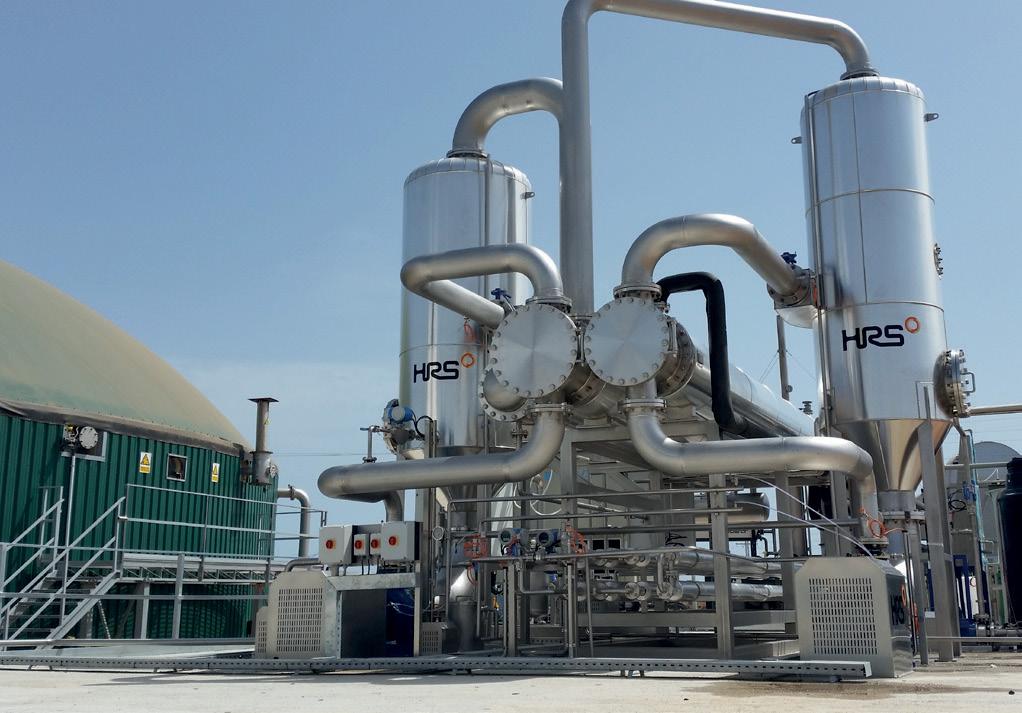

and operating guidelines for activated sludge mixing.
Aeration is typically where most power is used in a WRRF. Minimum aeration power is determined by mixing requirements, while mixing of unaer ated zones adds to power use. Tradi tional rules of thumb are often used to determine how much power is needed to keep mixed liquor in suspension.

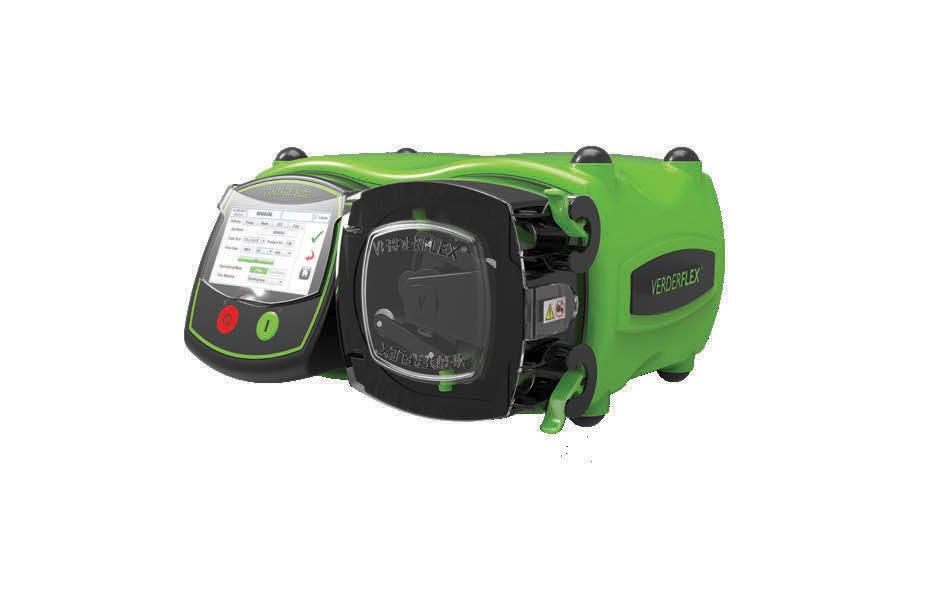
These are summarized in Table 1. At first glance, it appears confusing that mix ing the same material (activated sludge) requires such a variety of (at times con flicting) approaches and empirical design assumptions.
These design criteria likely origi nated from full-scale design and perfor
Well flocculated mixed liquor at a power level of 0.11 W/m3 (Schauer & Kobylinski, 2010).mance experience. While adopting such published design guidelines is safe, the drawback is that these guidelines tend to be set based on the worst-case (failed) designs and as a result tend to increase over time.
Indeed, the recommended mixing power requirement increased from 13 –26 W/m3 (Metcalf and Eddy, 1972) to 15 – 30 W/m3 (Ibid, 1979) to 19 – 39 W/m3 (Ibid, 1991) to 20 – 40 W/m3 (Ibid, 2003 and 2014). This is progress of the wrong kind, suggesting that the efforts our industry has made during the past three decades have resulted in ever less effi cient mixing systems.

Table 1 also highlights that, depend ing on basin dimensions, the results are surprisingly similar around 6 W/m3 or an air flux of 2.2 Nm3/h.m2. How ever, when one considers optimum mix ing intensities that were experimentally determined for flocculation, one finds that these translate to much lower energy intensities, between 0.23 and 1.2 W/m3, continued overleaf…
Mixing intensity expressd as Source Nm3/h.m2 (scfm/ft2) W/m3 (hp/mil gal)

Fine bubble aeration
Coarse bubble (20 scfm/ kcf)
- SWD = 13 ft (4.0 m) - SWD = 20 ft (6.1 m)



Channel aeration (2 scfm/ ft)




- Width = 5 ft (1.5 m) - Width = 15 ft (4.6 m)
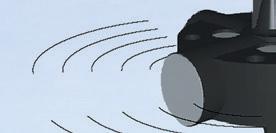

Mixer power in unaerated zone
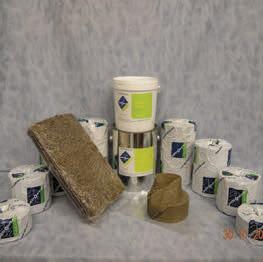
Velocity gradient, G - Optimum flocculation
- Minimum tested
2.2 (0.12) 6.0 (30) 77
4.8 (0.26) 7.3 (0.40) 13 (66) 20 (100) 114 141

7.3 (0.40) 2.4 (0.13) 20 (100) 6.6 (33) 141 81
2.9 (0.16) 5.0 (0.28) 8.0 (40) 14 (70) 89 117
0.15 (0.008) 0.58 (0.032) 0.083 (0.0045) 0.037 (0.002)
Table 1: Comparison of different mixing criteria.
0.40 (2.0) 1.6 (8.0) 0.23 (1.2) 0.10 (0.50)
20 40 15 10
or almost two orders of magnitude below some of the other criteria.


Presumably the mixed liquor needs to stay in suspension for flocculation to occur. The flocculation results suggest that optimization would allow mixing power to be much lower than indicated by traditional design guidelines.
This article includes a comparison of several full-scale mixing system case studies where operators experimented with lower power intensities. These illus trate the value of conducting a site-spe cific evaluation of the actual minimum power required to maintain adequate mixing of mixed liquor for facility own ers and operators. Also, they provide a template for how to conduct these kinds of investigations. This allows any facility operator to experimentally determine the actual minimum mixing require ments, without risking affecting WRRF performance, or the exceedance of efflu ent limits due to insufficient mixing.

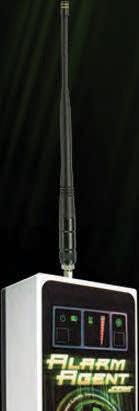

Aeration is typically where most power is used in a wastewater treatment facility. By determining the actual mixing and aeration requirements for each application, operators and design engineers can save power and potentially avoid unnecessary investments. Credit: Umpawan, stock.adobe.com

Schauer and Kobylinski (2010) tested the impact of impeller speed of an axial flow, top-mounted mixer in an irreg ular-shaped anoxic zone. Their results show that, in the second anoxic zone, reducing the mixing intensity from 4.5
to 0.11 W/m3 resulted in the maximum MLSS concentration difference increas ing from 3.4% to 5.5%. This suggests lit tle was lost in terms of homogeneity.
This is equivalent to reducing the air flux from 1.7 to 0.040 Nm3/h.m2, which is in line with some of the lowest power levels tested for flocculation and is a reduction of almost 98%. At the same time, the mixed liquor took on the appearance of extremely well flocculated solids.

They were not able to achieve the same results in the first anoxic zone. This suggests that the blending of the mixed liquor return flow and the efflu ent from the upstream anaerobic zone, introduced a few metres apart, limited the homogeneity of the mixed liquor at low power intensities.
Operators at one plant noticed that high DO concentrations in the down stream aerated zones were reducing the denitrification efficiency in the anoxic zones. It was determined that the aer ation system in these zones often oper
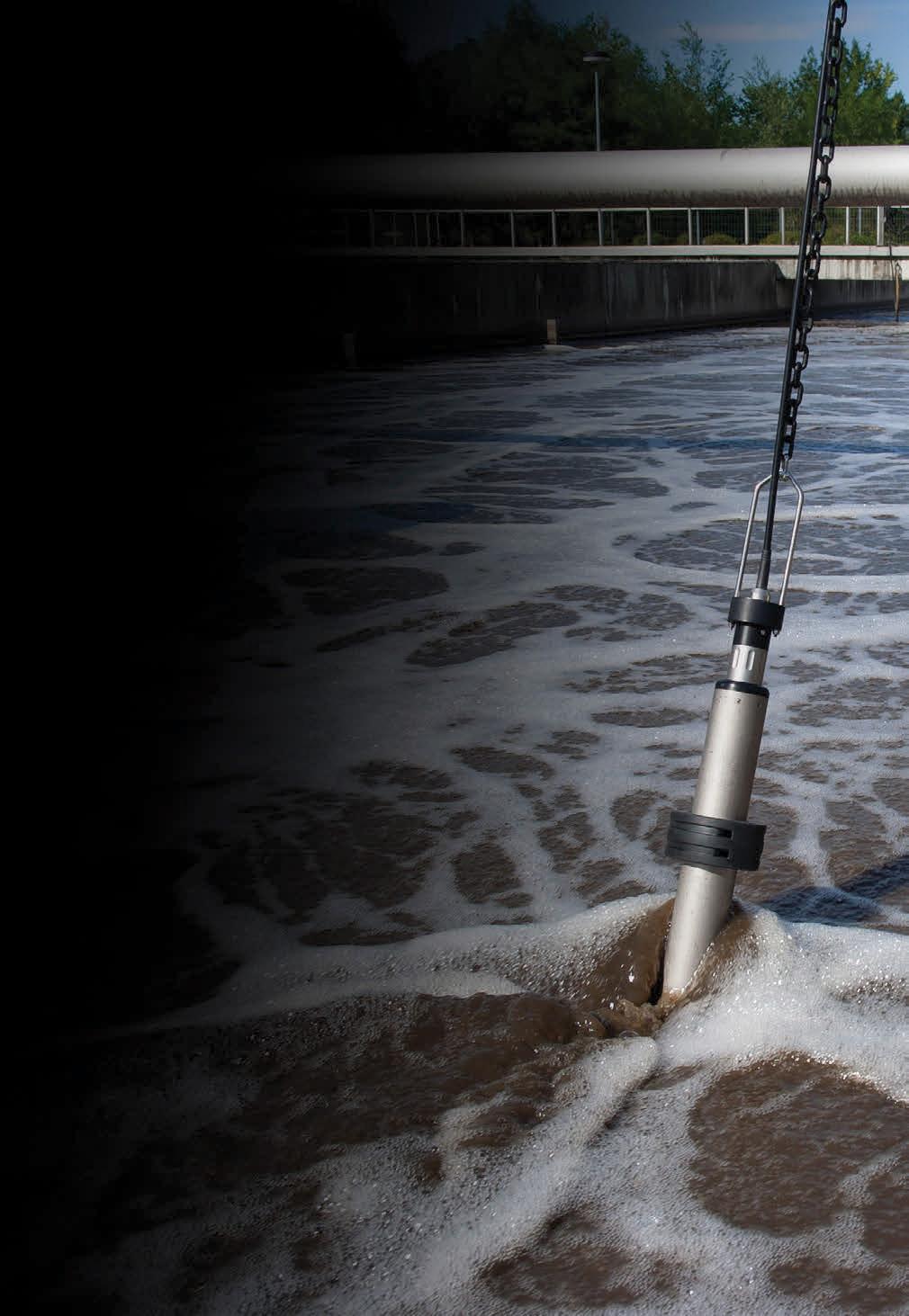

ates at mixing limited set points. To test the rule of thumb (2.2 Nm3/m2.h), one zone was operated overnight at an air flux of only 1.1 Nm3/m2.h. The next morning, profile MLSS measurements at multiple points in the zone revealed no distinguishable MLSS gradient.



As a result of these observations, the operators plugged diffusers in the second and third aeration grid, to make lower aeration fluxes viable without exceeding diffuser limitations. Then, they reduced DO set points in all aeration grids. They also decided to cycle mixer operation, so that each mixer only operates 30 min utes every 24 hours.
Thanks to these changes, and other sys tem improvements, the effluent total inor ganic nitrogen concentration dropped from 15 mg/L to 8.5 mg/L, while saving almost 2,100 kWh/d.
The same techniques can be used at any facility. There will usually be at least one aeration grid where airflow is main tained at the traditional mixing limit of 2.2 Nm3/m2.h, resulting in high DO




concentrations and potentially inhibit ing denitrification in upstream anoxic zones. By gradually allowing lower air fluxes, and leaving the system at these settings long enough for the solids pro file to stabilize, typically overnight, the impact of lower air fluxes on the solids profile can be determined experimen tally, using a Kemmerer sampler or a portable handheld TSS probe.



Before adding a mixer in an aerated zone with low oxygen demand, one would want to use this method to con firm that additional mixing is needed, and the expense is justified.


The same approach can be used to track changes to the solids profile after the mixer in an unaerated zone has been switched off, to determine the feasibility of cyclic mixer operation.
These examples illustrate that it is possible to improve effluent quality while saving power and operating cost. Depending on the plant loading and









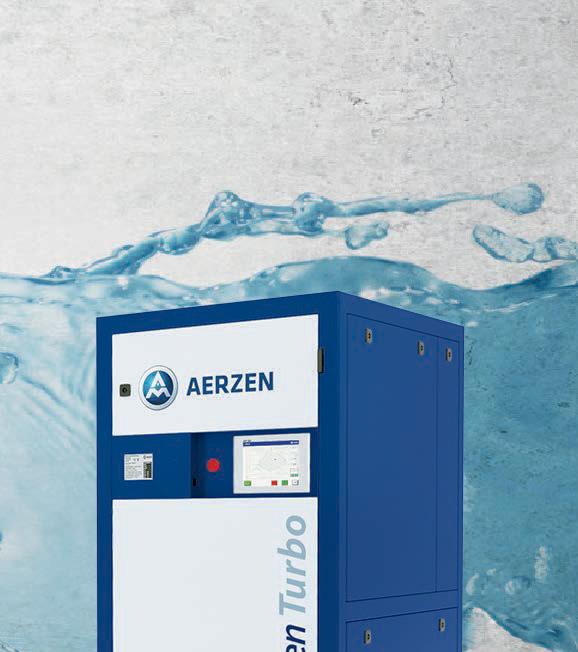
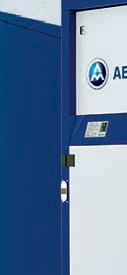


operating conditions, significant blower power may be saved. Cyclic operation of mixers may be used to reduce over all power cost or to minimize demand charges by minimizing mixer operation during daily peak rates. If the floccu lation of the mixed liquor shows a sig nificant improvement, one might even increase secondary treatment capacity.
Instead of accepting traditional rulesof-thumb at face value, there is an oppor tunity for plant operators and design engineers to determine the actual mix ing requirements for each application and use these to save power and poten tially avoid unnecessary investment.

References available upon request. Coenraad Pretorius and Jeremy Kraemer are with GHD. For more information, email: jeremy.kraemer@ghd.com




Hamilton is a port city on the west ern side of Lake Ontario with a population of 550,000. The Niag ara Escarpment runs through the middle of the city across its entire breadth, producing roughly 148 km of watercourses that flow through Hamil ton and feed into Lake Ontario.
Hamilton has two types of sewer sys tems. One is a separated sewer system, which has one pipe for sewage that gets treated at the wastewater plant and one pipe for stormwater that flows out to the natural environment. The other is a com bined sewer system that exists in older parts of the city where one pipe collects both stormwater and sewage, which goes directly to the wastewater treatment plant. Once the wastewater is cleaned it is discharged into Hamilton Harbour.
The city has nine large storage tanks that can hold 302 million litres of diluted wastewater in the event of extreme rain or snowmelt, so it is rare that wastewater treatment plant operators have no other option than to release diluted wastewa ter into the harbour.
At the end of 2001, the Ontario Min istry of the Environment, Conserva tion and Parks notified the city that there was E. coli present in the Red Hill Creek. Given that rainwater washes ani mal waste into streams and rivers, it is not uncommon to find E. coli in water courses when there are big rain events.
Calvin Huizinga, project manager of the sewer lateral cross connection pro gram for Hamilton Water, said: “It was important that we understood where this E. coli came from, so we ran a series of tests in storm sewer outfalls upstream of Red Hill Creek to determine if human waste was a factor in this E. coli discov ery. Unfortunately, the results indicated this was the case.”
Cross connection repair completed. The coloured pipe is a sanitary sewer lateral and the white pipe is a storm sewer lateral.

The city discovered that part of the problem was cross-connected sewer lat erals, from residences where builders had mistakenly linked sewage outputs to the storm sewer system. In addition, there were partial cross connections that typically occur from homeowner ren ovation projects, with new plumbing fixtures being connected to an internal stormwater drain.
The city immediately launched a sam pling program in 2002. “The starting point was easy, as we investigated the surrounding catchment area for Red Hill Creek,” said Huizinga. Crews sampled the storm sewers, and upon a positive result, they deployed CCTV into the storm sewer system during dry weather to look for the source of entry for human waste.
Once the source was determined, the
homeowner was contacted to advise them of the situation so that the city could gain access to their internal plumbing. This would allow crews to run a definitive dye test and another CCTV inspection to identify where the cross connection took place. Twohour on-site investigations cost the city around $650.
In two years, 153 storm sewer outfalls were investigated that were part of the two most significant (and environmen tally sensitive) watershed areas in the city: Cootes Paradise and the Red Hill Valley. They identified concerning levels of E. coli in 31 streams, indicating a high probability for cross connection con tamination.
“Unfortunately, we were met with some resistance from residents to
gain access into homes for dye test ing. Homeowners were concerned that they would be found at fault, resulting in fines and costly repairs. Our primary concern was to stop the flow of this raw sewage through the drains as it posed a serious health risk and environmental contamination at its final harbour des tination. So, in 2009 the city chose to waive owner liability, which significantly improved resident cooperation in giving us access for the final confirmation of what we suspected,” said Huizinga.
The city looked for ways to expand the program by identifying other hot spots, conducting regular testing and fixing the cross connections wherever they occurred. In 2009, the sewer lateral
one of Canada’s oldest water systems, so we have learnt how to get creative to get the job done. One corrected cross con nection diverts approximately 225,000 litres of sewage out of watercourses and into the treatment system each year. This has a significant impact on the health and safety of our residents and the health of surrounding ecosystems, which is why the city stepped up to fix these cross connections at a cost of $7,200 per resi dence for the full repair and restoration.”
Partial cross connections represent 10% of all identified cross connections in the city. Since the repair is required within the household, the city is not able to fix the connection. “We are still look ing at ways to deal with partial cross



sewer system. The city has conducted more than 615 dye test investigations, positively identified 376 homes with complete cross connections and con ducted 376 repairs. This amounts to one repair for every 750 m of inspection. This translates to more than 84.6 million litres of sewage being redirected from watercourses and the natural environ ment each day and into the city’s waste water treatment facilities.

In addition to field investigations and repairs, the city has also made changes to the building inspection program and created new bylaws to help prevent future cross connections. New subdivi sions are now required to dye test pri vate sewer laterals to ensure they are


including Hamilton Harbour and Lake Ontario. The city is committed to fixing this legacy issue and has identified and repaired a number of cross connections across Hamilton.”
In 2017, municipalities in Canada and the U.S. with cross connection issues were contacted to complete a survey for industry review. Participants were given an overview of the City of Ham ilton’s program and were asked to pro vide information about their own pro grams. Of the returned survey responses, only the City of Toronto and the Bos ton Water and Sewer Commission had well-established programs in place.
“This was definitely surprising to us, as cross connections are not an uncom mon problem. Yet it was clear that our relatively small city already had a mature program in place. Furthermore, we dis covered that we had corrected twice the number of cross connections per staff and at 12% less cost,” said Huizinga.

Hamilton also partnered with Redeemer University’s Environmental Studies pro



gram as they began actively monitor ing water quality in the Chedoke Creek watershed in 2012.

“Our students collect and analyse samples for a variety of biological and chemical contaminants. Nitrates, E. coli, total coliforms, phosphorus, chlorides (from road salt), and several others are being studied. It only makes sense that we share our findings with the city as we all have the same vested interest in restoring the health of Hamilton’s water sheds” said Edward Berkelaar, professor of chemistry and environmental science for Redeemer University.
The city, in turn, provided some fur ther insight into the civil side of how collection systems operate. “Environ mental stewardship is all of our respon sibility and the students of Redeemer are our future policy makers, water sci entists, operators and engineers. Part nerships like this accelerate a successful outcome,” said Huizinga.
An independent research project started in 2018 by a Redeemer University

student is looking specifically at “Micro bial Source Tracking of Fecal Contamina tion in Hamilton’s Chedoke Watershed”. Using cutting-edge lab equipment, the student was able to perform quantitative polymerase chain reaction (qPCR) lab procedures to isolate and amplify specific characteristics of the DNA to identify if the bacterial contamination was human or otherwise. Two of the seven sample locations registered human fecal con taminations of 10% and 13% of the total E. coli and five of the locations registered indiscernibly (<3%) small amounts.
“While the methodology and appli cation of this technology is fairly new at Redeemer University, we are all keen to better understand the sources of con tamination within our watersheds and to quantify the positive environmental impact of repairing cross connections,” said Huizinga.
The city has already inspected 25% of the storm sewer system, and plans to continue inspecting 46 km every year, until the entire separated sewer system has been reviewed. In addition, they have expanded the scope of the pro gram to include other potential sources and causes for sanitary sewer cross con tamination. With over 300 km of coded CCTV storm sewer footage as a result of searching for cross connections, it makes sense to leverage this data for a deeper structural pipe condition assessment.




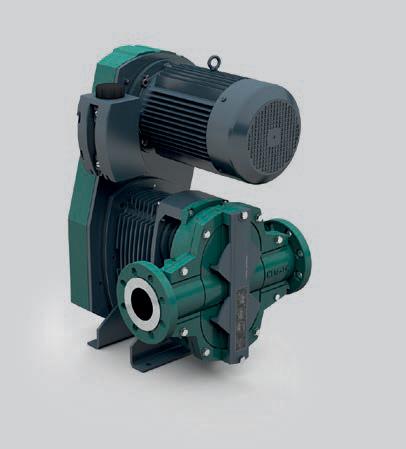
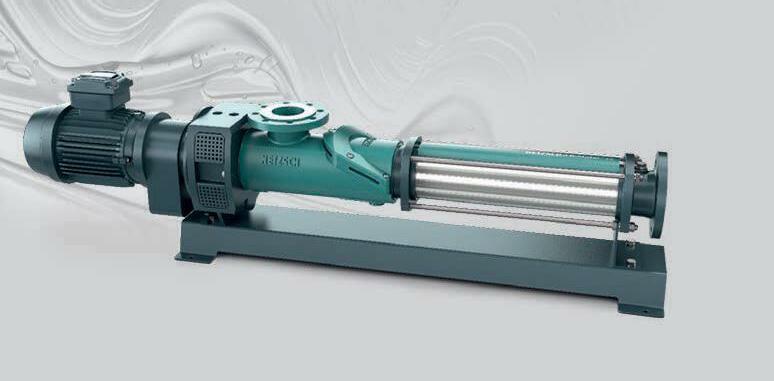

“We plan to work with environmen tal engineers to use this data with addi tional infrastructure records and inno vative software to pinpoint other poten tial sources of sewer cross connections, such as improperly abandoned sewer lines or sewer exfiltration. 84.6 million litres of sewage diverted from the envi ronment every year is something we are very proud of, but with human E. coli still present at outfalls we still have lots of work to do,” concluded Huizinga.
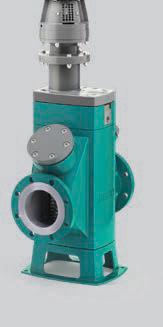

Dave Alberton and Donald Young are with Hamilton Water.
dave.alberton@hamilton.ca,
New Tecumseth is ready to confirm how much it will pay for the expansion of the Raymond A. Barker Water Treat ment Plant in Collingwood, Ontario, which has piped drinking water one hour south for more than 20 years as part of a collaborative agreement.

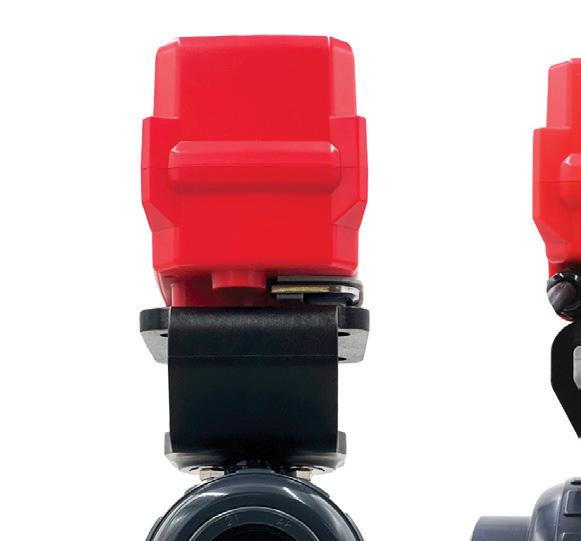
The towns, which have worked together since the expiration of their previous agreement in 2020, recently formed a new draft 10-year agreement to better position each municipal ity as their populations continue to grow and require greater water capacity.

The pipeline, which connects to a local reservoir, essentially began to support the construction of the sprawling Honda manufacturing plant expansion in Alliston, Ontario. The Town of Collingwood owned a rail line between Collingwood and Utopia and agreed to grant an easement over part of the railway lands to accommodate the transmission of water.
An announcement from the Town of Collingwood noted that the new agreement will include “an updated supply rate structure” that is “consistent with the principles of water rate setting by the American Water Works Association,” including cost recovery and asset management into the future.

“Collingwood has supplied water to the Town of New Tecumseth for over 20 years, and a new agreement will ensure that the best interests of both communities continue to be met in a transparent and financially responsible manner,” announced Sonya Skinner, Collingwood’s chief administrative officer, in a statement. “This collaboration will achieve greater efficiencies and enable growth for both communities,” she added.
The new rate will begin in January 2023, with a four-year transition period. It was established with the aid of Hemson Consulting Group. The rates range from $0.5 to $0.58 per cubic
metre in 2023 and increase to $0.62 per cubic metre by 2026, assuming a 2% consumer price index.

Until the new water treatment plant is built in Collingwood, New Tecumseth must purchase 9,000 cubic metres on average per day, up to a maximum of 9,500 cubic metres. In 2027, the minimum quantity will be 13,400 cubic metres. A new admin istration fee of $0.04 per cubic metre will commence on com missioning of the newly expanded water treatment plant.
In the terms of the transfer of pipeline ownership, New Tecumseth will be expected to pay $6.5 million to Colling wood in exchange for an 18.5% interest in the pipeline.
The two municipalities will also form a joint water commit tee to review planning for future expansions, maintenance and capital budgets, as well as supply rates.
“Both municipalities have been committed to working together to address our water supply needs for today and in the future,” said Blaine Parkin, New Tecumseth’s chief admin istrative officer, in a statement.
For more information, email: editor@esemag.com

The Town of Collingwood owned a rail line between Collingwood and Utopia and agreed to grant an easement over part of the railway lands to accommodate the transmission of water.
Kristjan, stock.adobe.com
Digitization has arrived as a bat tle cry in the daily operations of Canadian water utilities. Thou sands of sensors are pumping out millions of time-series data points, ven dor solutions compete to provide reams of analytic reports, and vast amounts of public data beckon that can inform wastewater flows, moisture impacts and other vital parameters.

There’s a ready, willing and able army of data-driven engineers armed with Python, Julia and R programming skills, keen to use predictive analytics and machine learning (ML) automation to tackle the challenges wrought by climate change-induced storm events, urban population concentration and ageing infrastructure.
It’s worth noting Python’s popular ity in particular. With a name inspired by the surreal TV sketches and mov ies of the British comedy troupe Monty Python, Python is a high-level opensource programming language. It was conceived by the Dutch programmer Guido Van Rossum in the late 1980s, during his Christmas break at university!
While he has since pursued a brilliant technical career working in the coding armies at Google, DropBox and most recently, Microsoft, he shouldered lead developer responsibilities for Python as “benevolent dictator for life”. This title was bestowed upon him after he passed his torch in 2019 to a five-member steering council that now leads the Python project.
The August 2022 edition of InfoWorld
With face pro, users can do things like convert measurement units, define lookup tables for weirs, flumes, and pipe cross-sectional areas, create rolling averages and sums, etc. Credit: dusanpetkovic1, stock adobe.com
reported that “unstoppable Python” topped the chart as the world’s most popular programming language. It reg istered a 15.42% market share, which is an all-time high for the language. It’s the only programming language besides Java and C to hold that No. 1 position.
Python courses are ubiquitous at Canadian college and university engi neering programs, not to mention those at MIT, Stanford and Carnegie Mel lon. And, the Coursera “IT Automation Python Professional Certificate” has a current enrollment of over 450,000 stu dents who pay an average of US$300 to complete that course in six months.
Python power and popularity has been built with extraordinary open-
source Python libraries for data science that are used by programmers every day in solving problems. For the uniniti ated, Python libraries are collections of modules that contain useful codes and functions, eliminating the need to write them from scratch. There are tens of thousands of Python libraries that help ML developers, data scientists and data visualization engineers, and more.
Python is the preferred language for machine learning, because its syn tax and commands are closely related to English, making it efficient and easy to learn. Compared with C++, R, Ruby, and Java, Python is one the simplest lan guages, enabling accessibility, versatility, and portability. It can operate on nearly any operating system or platform.

As an example of vast Python resources, Scikit-learn is an actively used library for ML. It includes easy integra tion with other ML programming librar ies like NumPy and Pandas. Scikit-learn comes with the support of various algo rithms such as classification, regression, clustering, dimensionality reduction, model selection, and preprocessing.
Built around the idea of being easy to use but still flexible, Scikit-learn is focused on data modelling. It is con sidered sufficient enough to be used as an end-to-end ML toolkit, from the research phase to the deployment.

Pandas is another notable Python library. It is primarily used for data manipulation and analysis. Pandas make working with time series and structured multidimensional data effortless for machine-learning programmers. Some
of the great features of Pandas when it comes to handling data are dataset reshaping and pivoting, merging and joining of datasets, handling of missing data and data alignment, hierarchical axis indexing, fancy indexing, and data filtration options.
As founder of the company that brought the flowworks flow monitor ing, analysis and reporting software platform to life in over 70 Smart City water utilities including Los Angeles County, Toronto, Seattle, and Dallas, I led a $4-million Digital Supercluster R&D consortium project that brought our technical team deep into Python’s potential for ML and other advanced data calculation applications.




The Fresh Water Data Commons project, now deployed in Andersen Creek in the Columbia Basin near the City of Nelson, British Columbia, uses an ML-enhanced version of the flow
works platform to transform data using Python scripts to build real-time analyt ics, predictive analytics and ML models.
The objective of the Canadian Fed eral Government’s Digital Supercluster initiative is to identify global indus try leaders and where Canadians bene fit from the prosperity and growth that comes from creating new products and services that are meaningful across the country and around the world. We did precisely that with a product launched at WEFTEC 2022 called face pro. Some of our Beta customers refer to it as “the Python tamer”.
A well-used toolset within flowworks, face stands for “flowworks advanced cal culation engine”. Using face pro, munic ipal engineers can create, edit and com bine data channels with mathematical functions. This allows them to create and define new datasets from incoming raw channels, using advanced math, statis continued overleaf…
tics and logic equations. Users can create, edit, delete and combine data channels with powerful mathematical functions for sophisticated real-time analysis.
With face, users can do things like con vert measurement units, define lookup tables for weirs, flumes and pipe cross-sec tional areas, create rolling averages and sums, build time-weighted averages of irregularly spaced data, and move data forward or backward in time to compare it with previously collected datasets.
Infinitii face pro, as the name suggests, takes advanced calculations and related automation to another level.
Users can literally cut and paste Python (or Julia or R) scripts into flow works production systems and then sec onds later, ML algorithms defined by those scripts are running system wide. After a recent demo of infinitii face pro, a senior software developer working at one of our flowworks engineering ser vices partners declared that “I can do my entire job inside this software!”
With infinitii face pro, flowworks users can easily deploy existing algorithms and calculations from the vast Python libraries technologists use every day. It’s as simple as cutting and pasting Python code into an intuitive interface, and then minutes or even seconds later seeing that code run in production systems.
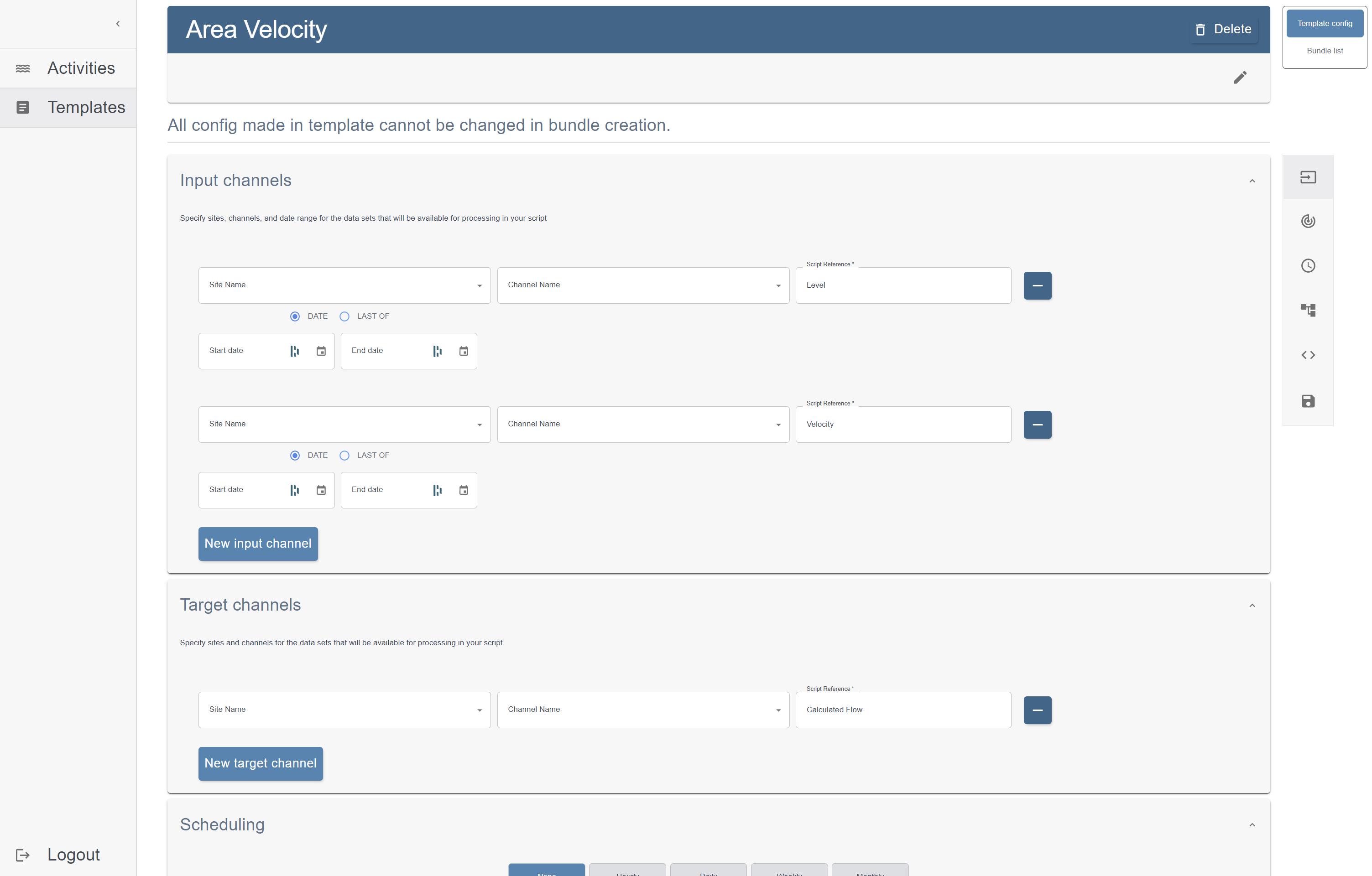
Use cases for this Python-taming calculation engine include forecasting, anomaly detection, predictive mainte nance and failure prediction. The types of advanced calculations easily performed with infinitii face pro include Soil and Water Integrated Model (SWIM) calcu lations that track and predict climate and land use change impacts at a regional scale, and evapotranspiration (ET) cal culations used to estimate soil-moisture storage based on precipitation deficit and the maximum water-holding capac ity of the soil.
Working alongside the flowworks platform, infinitii face pro provides a utility-wide data monitoring and report ing environment with state-of-the-art streaming data calculations that take advantage of the latest ML algorithms available in the vast Python libraries or created in-house to solve very spe cific problems. Significantly, flowworks “plays well with others,” and breaks down versus puts up barriers to working with data provided by other vendors.
Flowworks accepts all types of data from any source. Real-time, historic, wireless, satellite, SCADA, public data sets including USGS, NOAA and weather forecasts. It doesn’t matter where the data originates or from which sensor. You can connect it. Customers use flowworks daily to monitor water flow, rainfall, and other vital parameters in thousands of collection system metering points.
Eric Corey, the smart wastewater net work project manager at Core & Main, has stated that with flowworks: “We now
Infinitii face pro input data channel and target output data channel for area velocity.have the unique ability to treat data like data, not like countries.”
He continued, saying “given the com plexity of the Smart Wastewater Net work and the number of different soft ware solutions being utilized, what flow works provides us is a data Switzerland.
“This neutrality gives a required level of comfort to our other technology and manufacturing partners that allows us to truly innovate with their technolo gies versus being locked in or locked out from utilizing strategically import ant data.”
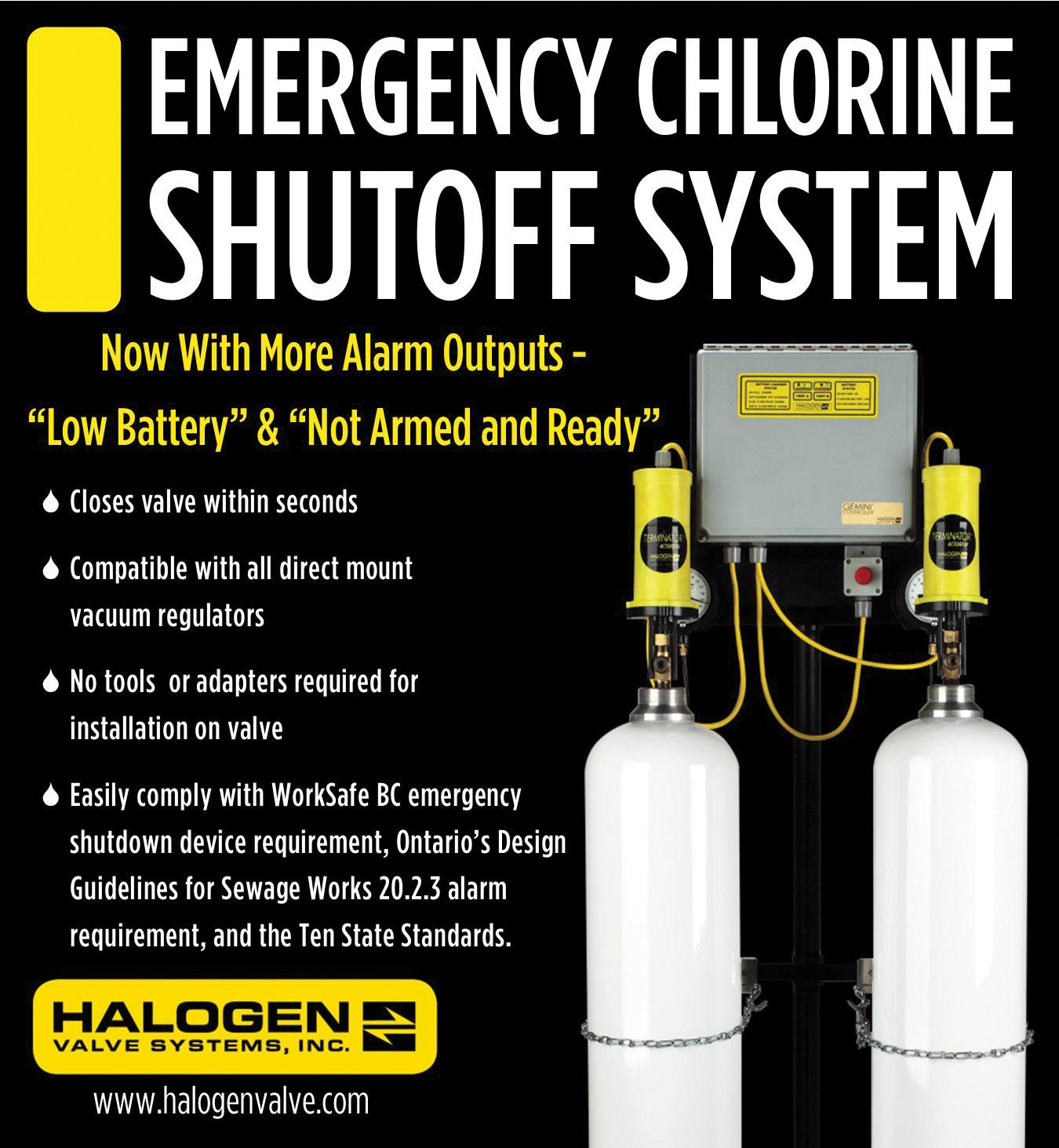
Infinitii face pro users working with the flowworks platform can build ana lytic models and transform raw sensor data in order to generate new data or output events in near real time. They can simultaneously filter, aggregate, enrich and analyze high volumes of time-series data from multiple sources, then present it using flowworks graphing and geo graphic information system (GIS) map ping tools like K2 Geospatial’s JMap.

Flowworks alarming and notification tools are readily employed, and infinitii face pro can also leverage Microsoft Power BI dashboards.
Greg Johnston is with infinitii ai. For more information, visit: www.infinitii.ai
Infinitii face pro area velocity results graph calculated from new data channel.The University of Waterloo is lead ing an interdisciplinary research team that hopes to unlock key information that will inform Cana dian water systems about potential PFAS contaminants and treatment options that could impact millions of Canadians.

Per- and polyfluoroalkyl substances (PFAS) will be monitored through the treatment process of seven Ontario water supply systems under the new research. The project will determine which PFAS are present in Ontario waters, as well as the chemical and physical processes underpinning treatment technologies.

This project will see water samples taken throughout the treatment process to determine which PFAS are present in Ontario waters. Credit: madamlead, stock.adobe.com
new water and wastewater treatment technologies,” said Scott Hopkins, project lead and professor in Waterloo’s Depart
Traditional water treatment methods are ineffective at destroying these chemi cals, added Hopkins, who says the carbon fluorine bond formed in PFAS is one of the strongest in chemistry. His team will focus on the detection, characterization, and use of machine learning models to predict the physicochemical properties of PFAS and the transformation products generated by the treatment processes.
The new project will see water sam ples taken from input and along various points throughout the treatment process. Researchers will focus on the following:
• Union water supply system
• Lake Huron primary water supply system

Elgin Area primary water supply system
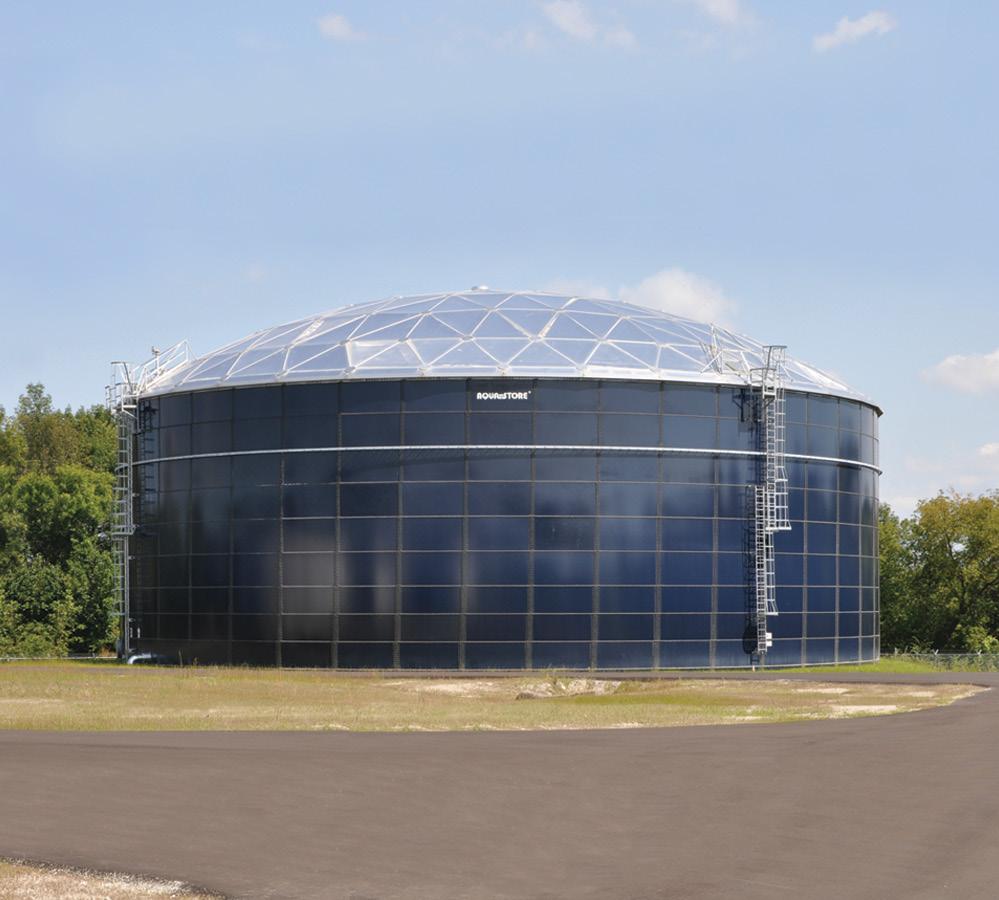
Lambton Area water supply system
Peel Region

City of Cornwall water system

The cities of Durham and London.

“Our specialty in ion mobility and mass spectrometry allows us to sepa rate complex mixtures and see what’s in them,” said Hopkins. “We also use machine learning to infer things about the chemical processes that we’re deal ing with and find the optimal treatment conditions so we can make the best use of the instrumentation we have.”
Hopkins has partnered with professor Franco Berruti from Western University. Western will focus on the treatment as Berruti and his colleagues at the Insti tute for Chemicals and Fuels from Alter native Resources have already made considerable advances in the destruc tion of PFAS in biosolids using pyrolysis, and in water via UV treatment.
Also partnering on the research proj ect will be USP Technologies, Brown and Caldwell, the Ontario Clean Water Agency, Ontario Water Consortium, Canadian Water and Wastewater Asso ciation, as well as the seven regional water supply systems.
For more information, email: editor@esemag.com

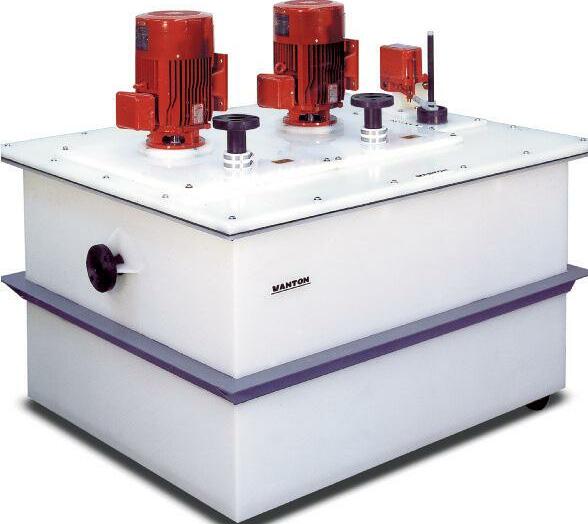

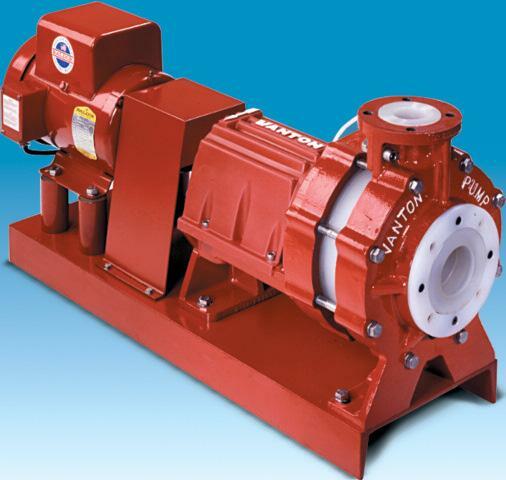

Technician performing arc testing on the walls of the tank.
Ensuring the integrity of a lined above ground storage tank can be very challenging. A recent project demonstrated that a new Canadian innovation in leak detection technology made the job a lot easier.
The project involved supply and installation of a 45 metre diameter x 9.7 metre tall steel tank to contain wastewa ter. Two layers of 2-mm thick high den sity polyethylene geomembrane were used to line the inside of the tank.
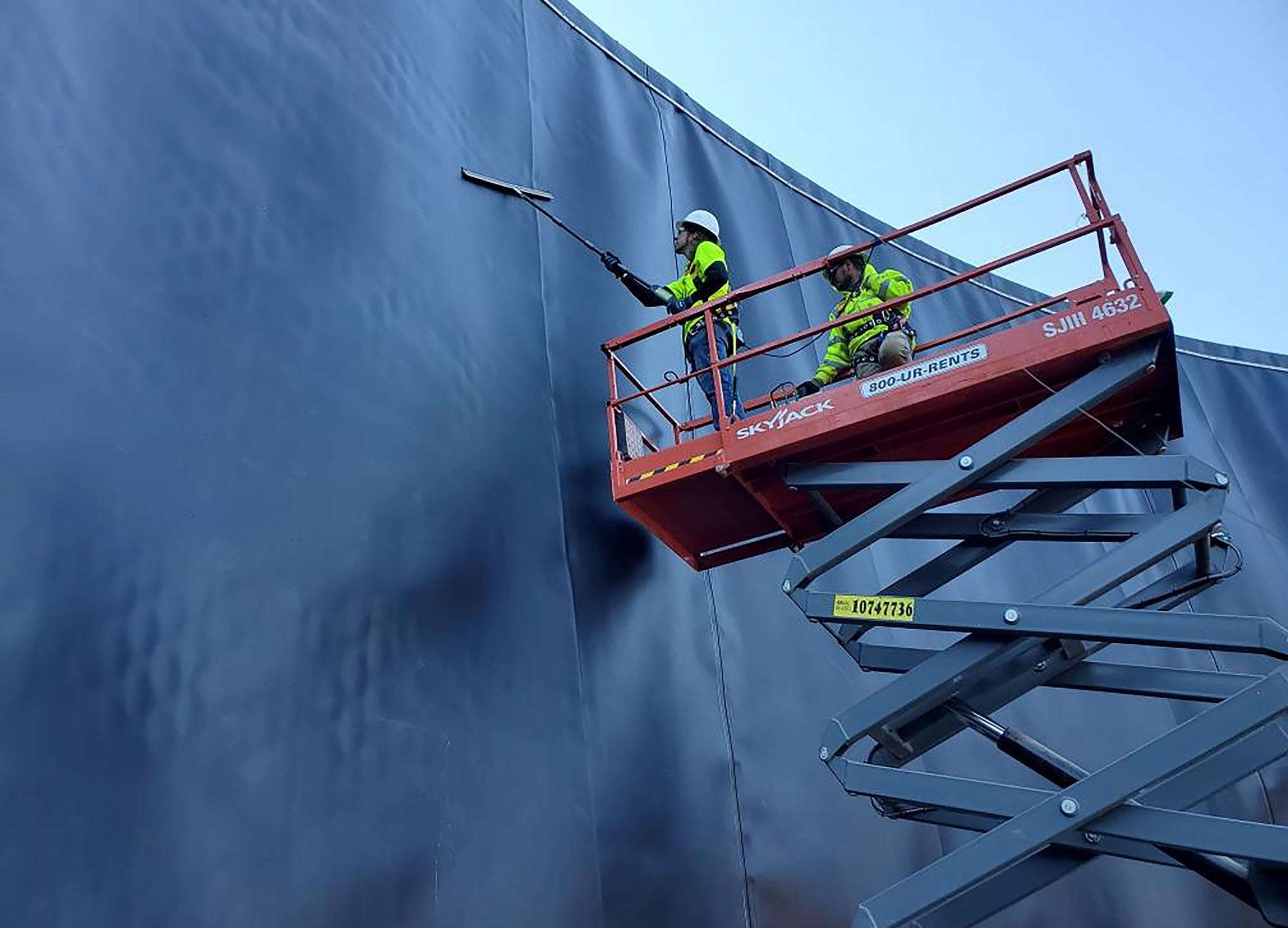
Part of the project scope was to per form a leak detection survey after liner installation using the electric leak loca tion (ELL) method. The challenge was to provide a conductive layer between the two layers of polyethylene liner that tra ditionally has proved to be a very diffi cult task.
Through the advice of the engineer who was to perform the leak survey, the contractor contacted Layfield to incor porate GeoVolt™, a conductive compos
ite that resembles a nonwoven geotextile, into the project. The result was a success ful installation with a high level of qual ity control and problem-free operation.
The tank is a typical steel walled sys tem with a primary and secondary poly ethylene liner suspended from the top using a perimeter batten bar. The Geo Volt conductive composite was installed between the two layers of liner to facili tate the ELL.
ASTM D7852 “Standard Practice for Use of an Electrically Conductive Geotex tile for Leak Location Surveys.” details the method used in this application. ELL is well known in the industry for substan tially reducing the probability of a leak in a lined system. It can detect even the smallest hole using DC voltage estab lished on either side of the plastic liner, with the liner becoming the insulator.
A hole in the liner will allow the DC circuit to complete, which creates a vis ible arc and audible signal, allowing the
surveyor to easily identify the hole.
Layfield’s GeoVolt is a conductive composite that combines a thin conduc tive film with a needle-punched nonwo ven geotextile. This unique manufac turing process creates a consistent con ductive material that can facilitate effec tive electric leak detection under most geomembranes. The nonwoven lami nate allows the material to double as a cushion layer.
This product was developed specifi cally to address several challenges cur rently faced when deploying electric leak location methods. Its benefits include:
• No need for water above the geomem brane.
• Consistent conduction of electricity beneath the entire lined surface.
• No need for special welding techniques.
• Can be used with any synthetic water proofing barrier.
Traditional means of establishing conductivity behind a liner would have
included wetting the space between lay ers of liner, which would have been very difficult in this case, especially up the vertical walls.
For this case, the contractor requested that the engineer identify potential leaks (if any) in the exposed HDPE primary geomembrane liner using the ELL arc testing method detailed in ASTM D7953.

A scissor lift was used to assist the ELL personnel in accessing the entire wall area of the tank. During the ELL, ambi ent temperatures ranged from approxi mately 15.5°C to 24°C, with sunny skies.
Before the ELL testing in the tank, a leak detection sensitivity test was per formed on a separate portion of liner material inside the tank. This was per formed to calibrate the equipment to on-site conditions.
A hole was made in a section of liner. When voltage was applied, a vis ible arc formed between the wand and the exposed liner at the puncture and an audio signal was heard from the test equipment (AP-W high voltage holiday detector). This confirmed the proper functioning of the equipment.




The ELL in the survey area was per formed using the settings established from the sensitivity test, applying a high DC voltage to a test wand above the exposed primary geomembrane liner sur face, and grounding the test equipment to the subgrade soils outside of the tank.
Arc generated close to a defect in the geomembrane.
The technician performed the survey on the wall and floor area of the tank. The wall area was tested from the floor to the top of the tank using one metre wide passes. Each subsequent pass over lapped the previous pass by approx imately 75 mm to ensure that all the exposed liner was surveyed. The same
procedures were used for the ELL test ing over the entire floor area.
During ELL testing, one defect (puncture) was detected on the pri mary geomembrane liner of the tank. The defect was located on the wall area of the tank, approximately 5 metres up from the tank’s floor and 30 cm left of a welded seam.
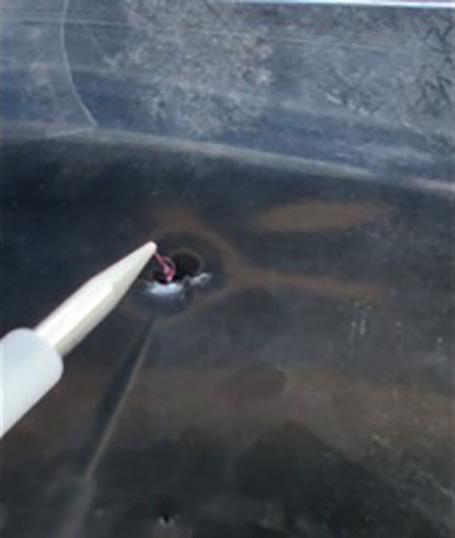
The conductive composite provided peace of mind to the owner as it helped guarantee the system’s leak-free integ rity. In this application, GeoVolt served both as a conductive layer and a drain age medium between the two liners.

Using a traditional geotextile between the liner layers would have required a large amount of water to wet the geo textile to try and establish conductiv ity before ELL testing. The excess water remaining in the leak detection zone would have had to be removed before filling the tank, incurring additional costs to the owner.
GeoVolt is a Canadian innovation that significantly reduces the poten tial for leaks in a plastic lined system. It proved to be very useful in this case due to the need to leak test the lined vertical walls and test the double lined system.

Rohit Sati is with Layfield Group. For more information, visit: www.layfieldgroup.com
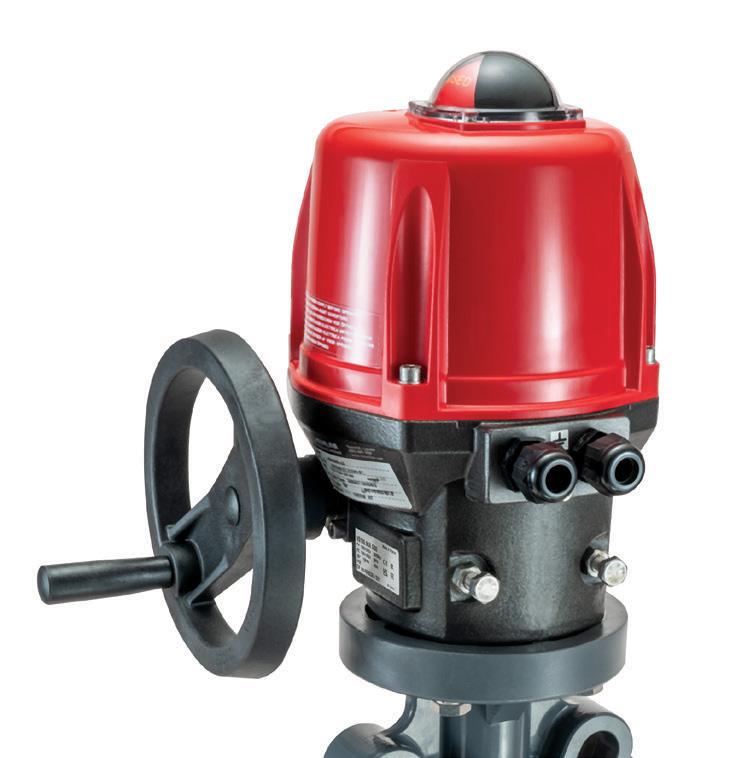
Aging water systems face a number of challenges, including a grow ing and urbanizing population, water scarcity and more extreme weather events, an aging workforce, and increasing expectations from customers.
For reasons such as these, water util ities worldwide are moving to more advanced operational management solu tions using the Internet of Things (IoT). These IoT devices can provide valuable insight into the operational efficiency of a water system and give utility operators the analysis and intelligence necessary to help make informed decisions for per formance improvement.
After hitting a static level of breaks and non-revenue water (NRW) loss, for Halifax Water (HW) the challenge is increasing leak awareness to reduce run time.
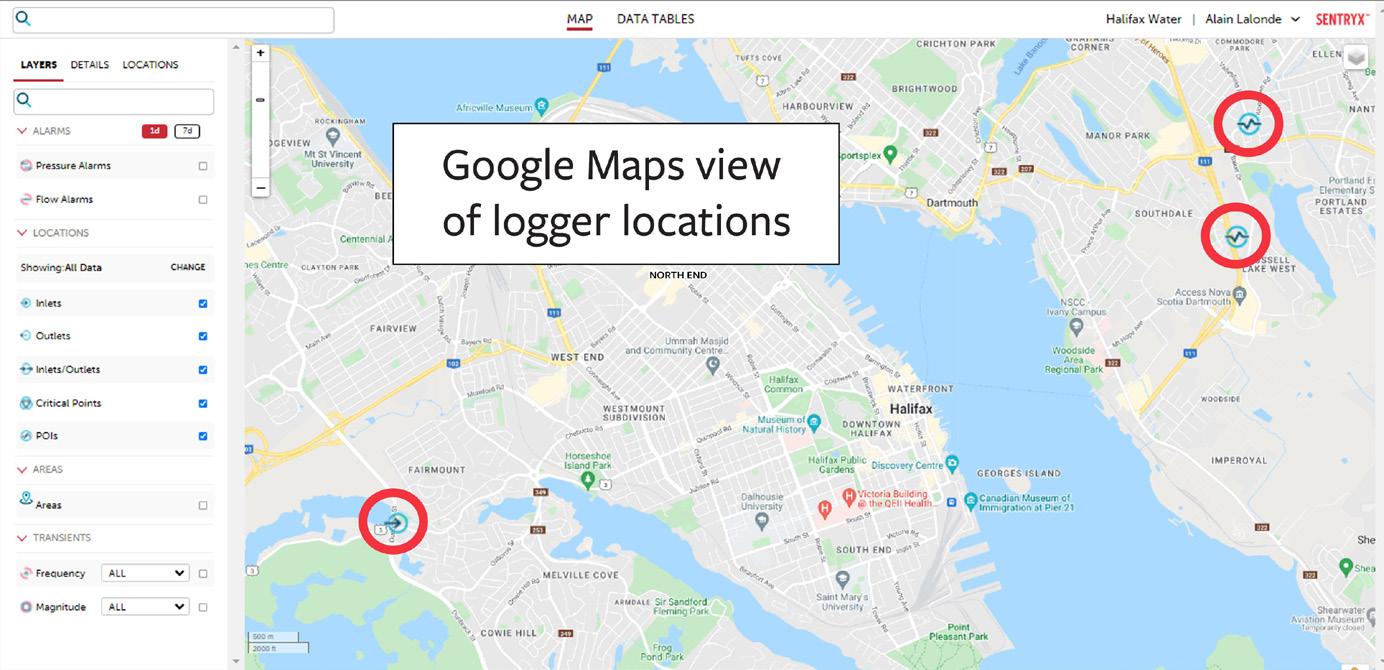
As part of its 2021-22 annual business plan, Halifax Water is developing rec ommendations to reduce NRW loss.
To help support these plans, HW part nered with Mueller for a performance trial of an advanced pressure manage ment and control platform. Kevin Healy, operations engineer with HW said: “We’ve worked with Mueller in the past, so we were eager to start the trial. Addi tionally, from a deployment perspective, our system already had district metered areas (DMAs) with pressure reducing valves, and access to an enabled LTE-M cellular network.”
While subdivision of the network into DMAs enables closer manage ment of pressure and leakage, pressure monitoring and control solutions can also be effective in open networks. The pilot program included three phases of implementation.
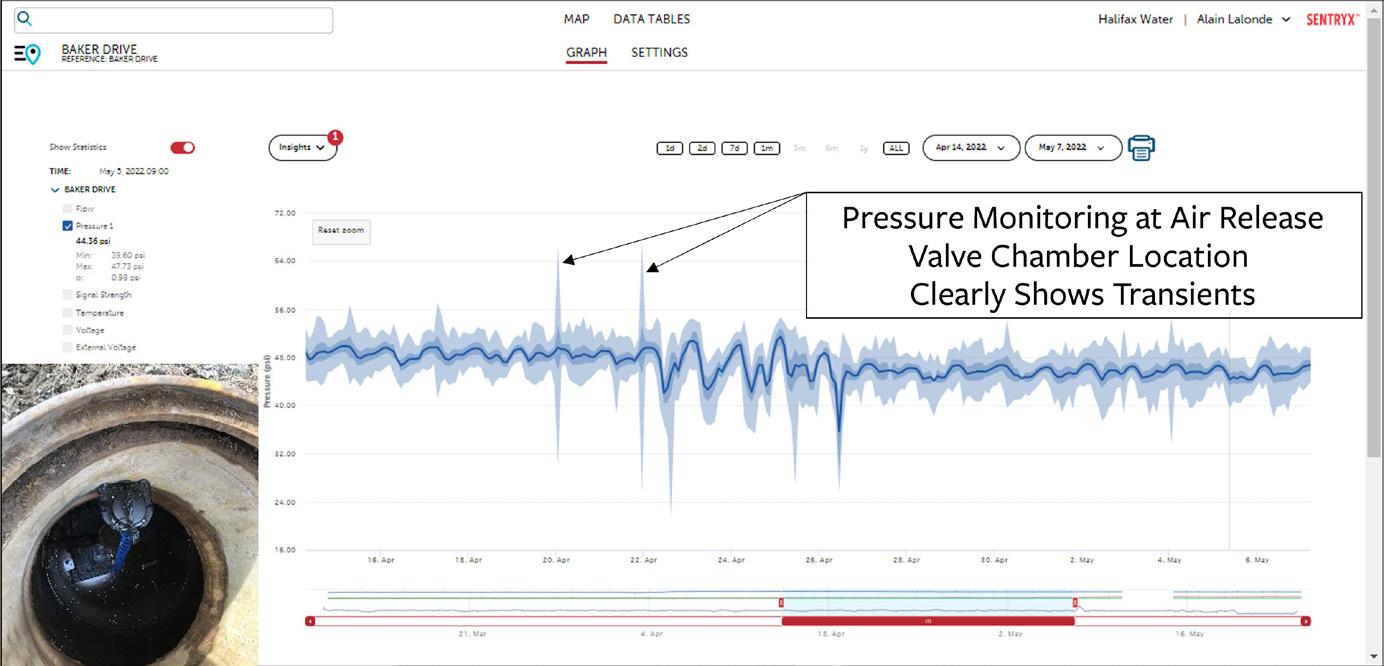
Phase one of the pilot program served to evaluate the communication and
reporting functionality of the pressure loggers, as well as the data analytics, notification alarms, and data visualiza tion of the Sentryx™ Intelligent Network cloud-based software service. A total of three pressure loggers were installed. Two are single-port pressure recorders within existing air release valve cham bers, and one is a triple-port pressure logger to record inlet, outlet, and control chamber pressure of an existing pres sure reducing valve (PRV) station.
The Sentryx Intelligent Network is a highly available, highly secure software service that stores data and maximizes the value available from it by applying machine learning algorithms and visu
alizes it in the most actionable formats. This includes maps, graphs and tables.
During phase one of the pilot pro gram, HW was able to derive valuable insights about its network that it did not have before and see these using the soft ware service’s maps and graphs.
Some of the most interesting insights included the detection of pressure surges and transients at one of its air valve installations as seen in Figure 1. It is a standard feature of the loggers that they collect statistical data that enables transients to be detected. In addition, a routine fire flow test could easily be identified, as seen in Figure 2.
While HW previously had pressure
Sentryx Intelligent Network web interface – site location map view. Figure 1. Pressure surging and transients detected at one of the Halifax Water air release valve locations.sensors reporting to SCADA, the Muel ler data loggers enabled the utility to monitor pressure and flow at air release valves (ARVs) and other locations with out existing power and communications, without the expense of adding power or communications in an existing chamber.

The “Zinck PRV station” seen in Fig ure 3 has a 100 mm PRV main supply and a 250 mm PRV fire flow backup. It is the only primary feed into the Mowatt intermediate DMA, as seen in Fig ure 4. The PRV was retrofitted with the advanced pilot valve (APV) with the existing PRV pilot system still installed, but valved-off to allow for backup con trol during routine maintenance. A con trol logger was also connected to the PRV. Utilizing the APV and control logger, the PRV can now be controlled remotely with the new advanced pres sure management system.
The Mowatt intermediate DMA in Halifax has 479 connections, 37 fire
hydrants and 52 mainline valves and 6.4 km of watermains. As the first proof of concept to HW, the APV pilot was locally set and programmed to operate as a nor mal fixed outlet PRV. The current PRV pilot system on the 100 mm PRV was set to a constant 71 PSI, and the APV was
programmed to regulate the PRV output to the same 71 PSI outlet pressure.

“I was impressed with how well the PRV outlet pressure was maintained –particularly in low-flow scenarios. The Sentryx software allowed us to change

the PRV setpoint remotely and even adjust the opening/closing speeds of the PRV to offer an even smoother outlet pressure,” said Healy.
Once the new pilot proved its ability to regulate and keep a constant outlet pressure, HW moved on to test control using “flow modulation”. In flow modu lation, the PRV outlet pressure is varied based on the actual demand in the DMA.

This allows a lower pressure set point at night when demand is low and sys tem head loss is at its minimum. During peak demands, pressure is increased to overcome system head loss and ensure sufficient pressure within the DMA.
Flow modulation is ideal for lower ing pressure in off-peak demands to reduce leakage flows and the occurrence of watermain breaks. It also responds quickly to increase pressure at peak demands or for fire flow requirements.
Figure 3. APV and controller installed on a 100 mm Singer 106-PR pressure reducing valve.
matic optimization mode, the system takes in data from the PRV and from a logger placed deeper in the network where the water utility wants to deliver fixed pressure levels. That position is
week. The Sentryx Intelligent Network software service does the rest. It receives data from the PRV control logger and the control point logger and calculates the optimal control curve to achieve the
It then makes adjustments to the PRV outlet pressure continuously. The profile is created in the software service, then

sent down to the control logger. It takes just seven days to be confident in its first curve. The curve is automatically re-cal culated regularly to account for changes in demand. These may be seasonal or may result from changes in customer usage in that area of the network over time (e.g., the building of new housing).
The system ensures that pressures are maintained at the minimum viable level at all times. This in turn reduces leakage and the likelihood of pipe bursts. This method of optimized pressure manage ment gives HW the highest level of secu rity of supply.

Although the DMA flow profile and “night flow” for the Mowatt intermedi ate zone shows that there is very little leakage in this zone, HW was still able to obtain savings from the optimized PRV control mode. Under fixed outlet control, the average daily DMA demand was 210 m3/day (55 kGal/day).
In optimized PRV control mode, the daily DMA demand was 204 m3/day, a savings of 6 m3/day or 2.8% of the aver




Figure 4. Mowatt intermediate district metered area.

age daily demand. In a pressure zone or DMA where leakage levels are 10%, 20%, or even 30%, the savings would be sig nificantly higher.
Harold Mosley is with Hydro-Guard, Mueller Water Products. Email: hmosley@muellerwp.com



 By Francine Kelly-Hooper, Krista Barfoot, Luicito Dela Cruz and Glenna Pike
By Francine Kelly-Hooper, Krista Barfoot, Luicito Dela Cruz and Glenna Pike
Thousands of stormwater man agement (SWM) ponds are engi neered to provide flood protec tion and water quality treatment for urban developments across Canada. The Ontario Ministry of the Environ ment, Conservation and Parks (MECP) requires the routine removal of accu mulated sediments in order to maintain flood control and water quality treat ment efficiencies. Municipal and private SWM pond owners can spend hundreds of thousands to millions of dollars on waste disposal fees for each pond.
Landfills are beginning to refuse sed iment due to limited storage capacities. Trucking to distant disposal locations can significantly increase costs and greenhouse gas emissions. These issues highlight the growing need to identify beneficial reuse options for SWM pond sediment.
Ontario Regulation (O Reg.) 406/19, On-Site and Excess Soil Management, was released by the Ontario Ministry of Environment, Conservation and Parks (MECP) in December 2019, with a phased approach, coming into full force on Jan uary 1, 2021. O.Reg. 406/19 provides pre scriptive rules for SWM pond sediment sampling and quality assessment.
Th is study focused on the likelihood that the new sampling rules, which are discussed as follows, may affect future SWM pond sediment beneficial reuse options:
Sediment must be tested for the fol lowing analytes: Bulk Soil – BTEX (ben zene, toluene, ethylbenzene, and xylenes); petroleum hydrocarbon (PHC) fractions F1 (C6-C10), F2 (C10-C16), F3 (C16-C34), F4 (C34-C50), F4G (gravimetric); poly
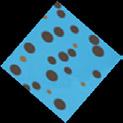
cyclic aromatic hydrocarbons (PAHs); electrical conductivity (EC); sodium adsorption ratio (SAR); cyanide; metals and hydride forming metals.
Metals must also be tested for the Synthetic Precipitation L eaching Proce dure (SPLP) leachate. O. Reg. 347 Tox icity Characteristic L eaching Procedure
(TCLP) analysis is required for sediment that would be sent to registered waste disposal facility.
Variations to these prescriptive sam pling requirements may only be applied if a site specific instrument is obtained to allow an alternate sampling process (e.g., wet in situ sampling, alternate
sampling frequencies, etc.).
Bulk soil analysis results are typically evaluated for exceedances of the generic O.Reg. 153/04 Table 1 background Site Condition Standards (SCS), and the O Reg. 406/19 Table 2.1 (for potable groundwater) and Table 3.1 (for non potable ground water) Excess Soil Quality Standards (ESQS) for residential/parkland/institu tional (RPI) and/or industrial/commer cial/community (ICC) property use. Ben eficial reuse requirements for SWM pond sediment align with those of other excess soils, including the need to meet the SCS, ESQS, or applicable site specific standards, with some exemptions for salt impacted materials. The above mentioned tables are available online at: www.esemag.com/ swm pond sediment survey
Sediment must be dried and stock piled prior to ex situ sampling. Previ ously, typical sampling practices col lected wet in situ sediment samples from undrained pond basins. Th is approach allowed sediment to remain in the basin for up to two years while beneficial reuse
1Table 1
Notes:
sites were identified and approved. Many SWM pond properties do not have suf ficient space to facilitate on site stockpil ing and drying, meaning the sediment would need to be transported to an off site location prior to sampling.
Un dewatered sediment (liquid soil) that does not meet O Reg. 347 solid waste slump test requirements must be trans ported in a vehicle that is equipped with a locking valve system (e.g., hydrovac truck)

On site mixing of sediment with bulking or dewatering agents can meet slump test requirements.. However, the

characteristics of the final mixed mate rial may not be suitable for all beneficial reuse options (e.g., topsoil amendments, non structural fill, etc.).
Dried ex situ samples may be collected from separated Inlet, Centre and Outlet sample zone stockpiles or from one com bined stockpile; however, the sampling frequency is greater for the latter.
The Toronto and Region Conserva continued overleaf…
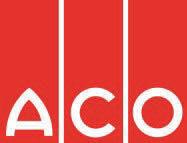
tion Authority (TRCA) 2016 Stormwater Management Pond and Wetland Sediment Inspection and Maintenance Guide pro vides a protocol for collecting only three composite in situ samples for bulk soil analysis from each zone for ponds that have one inlet, with one additional sam ple zone added for each additional inlet. ( https://sustainabletechnologies.ca/app/ uploads/2018/04 /SWMFG2016 Guide_ April-2018.pdf)
While the new Excess Soil rules would allow three stockpile samples per 600 m3, this number would be substantially higher for larger sediment volumes. For example, 5 samples per 1000 m3, 25 samples per 5000 m3, 50 samples per 10,000 m3, etc.

The objectives of this study were to:
• Determine the percentage of ponds that would meet O.Reg. 406/19 benefi cial reuse requirements;
• Determine if the wet in situ qual ity results were significantly different between the Inlet, Centre and Outlet sample zones; and,

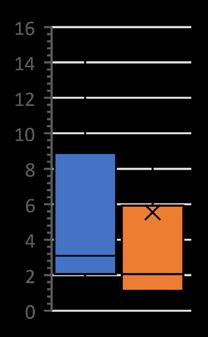
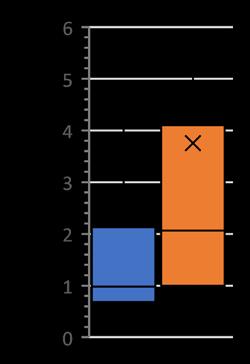

• Evaluate differences between the wet in situ versus dry ex situ sediment qual ity results.


Dr. Francine Kelly-Hooper designed and operated this field study from 2005 to 2022 A total of 371 sediment samples were collected from 121 municipal SWM ponds located in the provinces of A lberta, British Columbia, Manitoba, Ontario and Saskatchewan. The ponds ranged from approximately 15 to 30 years of age and were located in fully developed resi dential and commercial catchment areas.
Sampling took place as part of routine maintenance activities. Detailed sam pling methods can be found in Section 6 of the TRCA 2016 Stormwater Man agement Pond and Wetland Sediment Inspection and Maintenance Guide.
Design drawings and aerial photo graphs were used to delineate a min imum of three sample zones for each SWM pond consisting of Inlet, Centre and Outlet. Ponds with more than one inlet were sampled by adding one addi
tional sample zone per additional inlet.



Open water ponds were accessed either by an inflatable pontoon boat during thawed conditions or by cutting holes through the ice during frozen con ditions. Field staff accessed heavily vege tated ponds by wading to a safe distance from the shoreline. A 91-cm AMS sedi ment core sampler was used as the pre ferred method of collecting full depth fine silt and clay samples that were at least 15 cm deep. A n Ekman dredge was used for shallow coarse samples that could not be collected with the core sampler.
The sediment sample collection and processing protocols for bulk soil anal ysis were somewhat different between the 2005 and 2016 – 2022 dates. The
2005 protocol collected one discrete core sample from each zone. Each core sample was shipped in its dedicated core tube for processing and analysis at the ALS Environmental L aboratory located in Waterloo, Ontario.
Each core was laid onto aluminum foil sheets and sampled with a stainless steel spoon for volatile BTEX and F1 PHCs. Each of these unmixed volatile samples was placed into soil jars without head space. The remaining sediment core was homogenized in a stainless steel bowl before it was scooped into soil jars.
The 2006 – 2022 protocol collected one composite from approximately four discrete samples per zone and homoge nized the discrete samples collected from each zone into one composite non vola continued overleaf…







































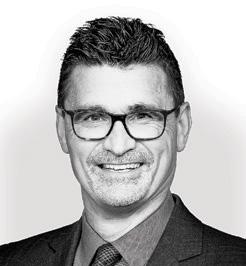








tile sample before transferring to soil jars. The 2006 – 2015 volatile analyte samples were collected from the first discrete sample and deposited into soil jars that were filled to the top without headspace. The 2016 – 2022 protocol used a Terra Core sampler to collect volatile samples from the first discrete sample, which was placed into methanol preserved vials.
Th is study dried 31 wet in situ sam ples that were collected from 11 of the original 121 SWM ponds. Portions of the homogenized bulk soil samples were placed into clean plastic bins, which were allowed to air dry until they were able to hold their shape as a soil rather than sediment consistency.
Samples 1 to 19 were dried for seven to 12 weeks, while samples 20 to 31 were dried for four weeks. The longer drying period for the first group consolidated the samples to such a hard consistency that a food processor was required to break them up prior to placing them in sample jars. The shorter drying time for the second group of samples produced a looser consistency that allowed them to be manually mixed with a spoon before placing them into sample jars.
Every sample was analyzed by ALS Environmental in accordance with ISO 17025 standards.
The one way analysis of variance (ANOVA) was used to assess whether the sediment contaminant levels in the samples collected from the Inlet, Centre

and Outlet zones were significantly dif ferent or not.
The Shapiro-Wilk test showed that many variables came from popula tions that were not normally distributed. Hence, the non parametric K ruskal-Wal lis Rank Sum Test was performed to determine whether the sample means of the sediment chemistry data taken from different zones were significantly differ ent. For the pairwise comparison of the means, the Dunn’s test using rank sums was used as a non parametric approach.
The greatest number of regulatory exceedances occurred for EC and F3 to F4G PHCs. Summary Table 1 shows that at least 81% of the ponds exceeded each applied soil standard for EC At least 77% of the ponds exceeded each applied stan dard except Table 3 1 ICC for F3 PHCs, which was exceeded by 18% of the ponds.
The above mentioned tables are available online at: www.esemag.com/ swm pond sediment survey

Figure 2 provides boxplots for nine analytes that exceeded different stan dards for wet versus dry samples. There were no trends to indicate that exceeded different standards. A lthough the pH levels were higher in the wet samples, the pH for all 62 samples ranged from 6 9 to 7 9, which was within the O Reg. 406/19 acceptable range of pH 5-9 The following analyte medians were higher in the wet samples: SAR , F2 and F4 PHCs. The following analyte medians
were higher in the dry samples: F3 PHCs and three PAHs.
The non parametric Dunn’s Test of multiple comparisons using rank sums identified significant differences between the Inlet, Centre and Outlet zones. The Figure 1b scatter plot shows the 17 analytes that exceeded at least one ESQS and that were significantly differ ent between zones. The greatest differ ences for 17 analytes occurred between the Inlet and Outlet. A lower number of eight analytes were different between the Inlet and Centre. There were no sig nificant differences between the Centre and Outlet zones.
The flow chart shown in Figure 3 sum marizes the relevance of the in situ sedi ment quality results to the O Reg. 406/19 beneficial reuse evaluation process. Salt and PHC contaminants were the leading causes of the SCS and ESQS exceedances.
Results indicate 81% of ponds would require application of salt exemptions to support reuse, due to elevated EC levels. Due to elevated PHCs, an Environmen tal Compliance Approval (ECA) instru ment would be required to support reuse for 87% of ponds that exceeded Table 2 1 for all land uses, 77% that exceeded Table 3 1 for R /P/I land uses and 32% that exceeded Table 3.1 for ICC land uses. The O Reg. 208/19 Sewage Works Consoli dated Linear Infrastructure ECA is gen
erally the most suitable instrument for SWM pond sediment beneficial reuse approvals. The above mentioned tables are available online at: www.esemag. com/swm pond sediment survey
The wet versus dry sediment study indicated that either in situ or ex situ sampling protocols would generally lead to the same beneficial reuse conclusions.





The sample zone sediment quality comparisons found the greatest sig nificant differences between the Inlet and Outlet zones, moderate differences between the Inlet and Centre zones and no significant differences between the Centre and Outlet zones. Th is indicates that the three composite sample zone approach does typically represent the overall contamination levels throughout the entire basin area.
Francine Kelly-Hooper, Krista Barfoot, Luicito Dela Cruz and Glenna Pike are with Stantec Consulting.

Email: francine.kellyhooper@stantec.com, krista.barfoot@stantec.com, luicito.delacruz@stantec.com, glenna.pike@stantec.com
For references and additional information tables, visit: www.esemag.com/ swm-pond-sediment-survey

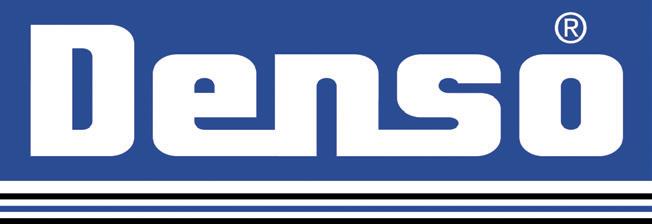
 By Matt Hale
By Matt Hale
Heat exchangers often play an important role in wastewater treatment systems. But given the nature of wastewater streams and the processes involved, including evap oration and anaerobic digestion, it is important that the right technologies are selected to maximize process and energy efficiency.
There are a number of applications for heat exchangers in wastewater treat ment. They can be used to recover heat from raw or treated sewage, to preheat sludge prior to anaerobic digestion, or to remove water from wastes and slud ges through evaporation.
Pasteurization of waste streams may be required to meet environmen tal rules, or water or effluent may need cooling before it is discharged to the environment in order to meet local leg islation. Each process will place different demands on the heat exchanger being used, and some processes may be com bined (e.g., recovering heat from treated sludge and using it to pre-heat untreated sludge before digestion).
The basic practical considerations when choosing a heat exchanger for wastewater treatment are the same as for any other application. These include the physical space available, the temperature of the product and process materials and the required temperatures after pro cessing, acceptable pressure drop, and the service materials being employed.
However, there are also other con siderations, which, while not unique, are particularly relevant to wastewater and sludges. These include the physical nature of the material and the potential for fouling in the heat exchanger, ease of maintenance and the ability to operate reliably for long periods of time.
General considerations, such as energy efficiency, capital and operating costs are also crucial to the final choice of a heat exchanger. The total cost of
ownership should be considered, as units that are cheap to purchase often have higher running costs, or lower operational efficiencies.
Obviously, the biggest factor when choosing a heat exchanger is the nature of the material itself. Some wastewa ter streams will be relatively clean, con taining only a few dissolved chemicals, while others will be a mixture of dis solved and suspended materials. At the other extreme, the thickest most vis cous semi-solid sludges will need signif icant power to move them through the exchanger, and the risks of fouling and the importance of the pressure drop will therefore be much greater.
Several types of exchangers are uti lized in wastewater treatment with dif fering levels of success, according to the type, the actual design of individual units, and the processes they are used for. The four types of heat exchanger
encountered in wastewater treatment are spiral, plate, tubular, and scraped surface:
Spiral heat exchangers (SHEs), which are sometimes known as shell and coil heat exchangers, are almost uniquely used in wastewater and sludge applica tions. They consist of a single channel formed into a spiral or coil, creating a compact design. Various options such as wider spacing and the removal of baf fles are employed to try to reduce foul ing and the design’s large surface area and true counter-current flow result in high thermal efficiency. However, they require regular cleaning (which is both time-consuming and costly) and are often unsuitable for sludge-to-sludge heat transfer.
Plate heat exchangers (PHEs) are one of the most common types of heat exchanger and they have a compact design with good thermal efficiency.
The patented HRS Unicus scraped surface heat exchanger is designed to prevent fouling during evaporation.However, they are highly prone to fouling and are often only suitable for relatively clean, non-viscous materials. Their maintenance schedules also often require regular replacement of the bespoke gaskets that separate the plates.
Tubular heat exchangers, also known as shell and tube, comprise a tube or tubes within another tube or vessel. Because of the various designs and geometries available, they are better able to cope with more viscous materials and suspended solids. Depending on their design, they can require more space than some other designs, and can be susceptible to fouling.
These issues are greatly reduced by using corrugated tube designs, and HRS produces a range of efficient and cost-ef fective corrugated tube heat exchangers for wastewater and environmental use, depending on the viscosity and physical characteristics of the product. These include the DTI and DTR Series of Double Tube designs for more viscous products, and the C & K Series of Multi-Tube designs for lower viscosity flu ids which may contain small particles.
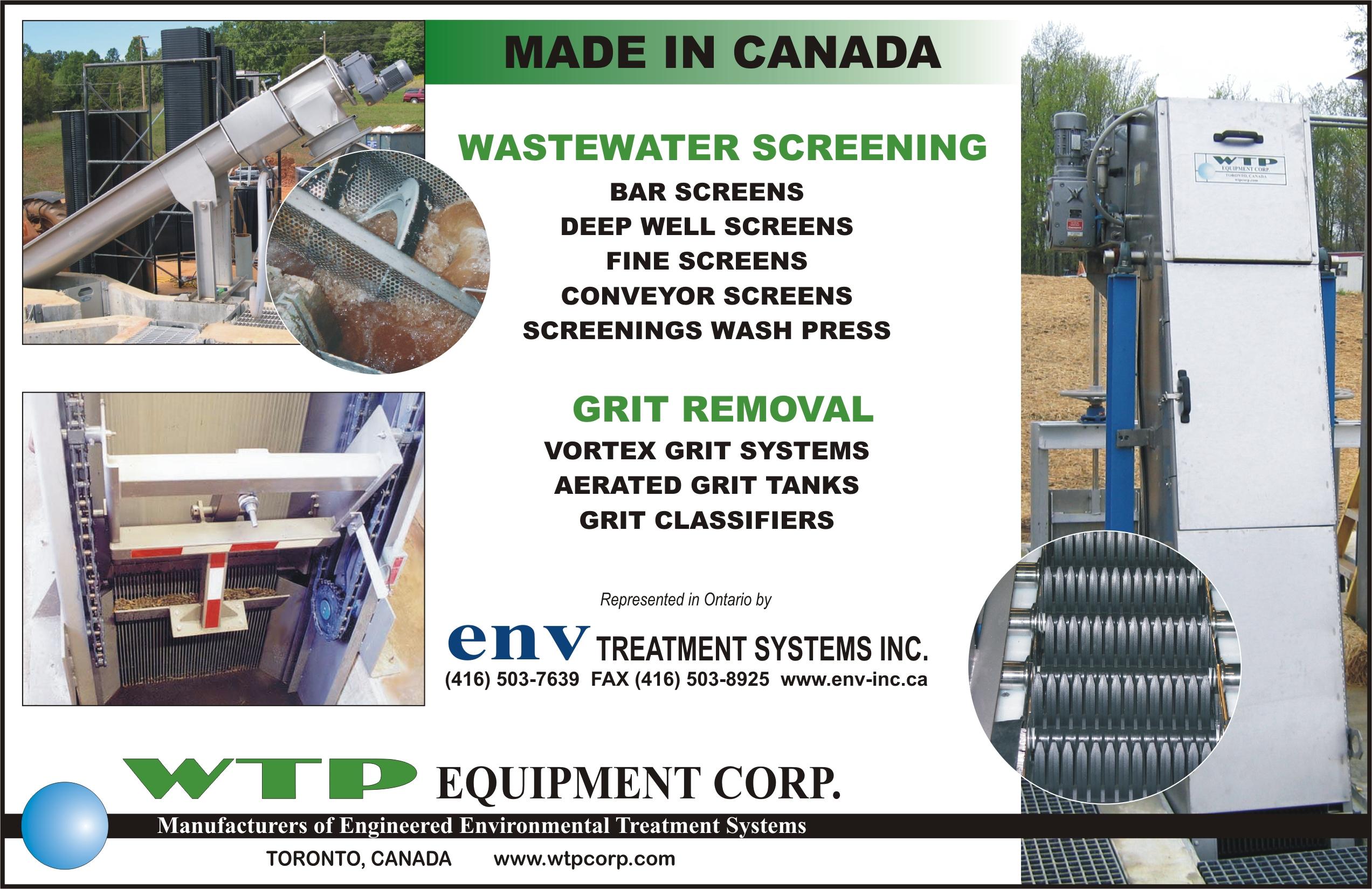
Scraped surface heat exchangers (SSHEs) are used where materials are very viscous or have a high fouling potential, so they are particularly suited for treating thick sludges and for use in evaporation systems. The use of a scraper keeps the tube surface clean and maintains high thermal efficiency, while the individual design may provide other benefits, such as con trolling product viscosity during processing.
HRS offers two different types of scraped surface heat exchanger, but the most suitable for wastewater applications is the patented Unicus Series. It uses a reciprocating action with
The HRS DTI Series of heat exchangers is ideal for heating sludge, for example in anaerobic digestion situations.

a choice of scraper geometries, making it ideal for applications such as effluent evaporation, where fouling or low heat trans fer is a problem.
Matt Hale is with HRS Heat Exchangers. For more information, email: info@us.hrs-he.com, or visit: www.hrs-heatexchangers.com
In April 2022, the U.S. Department of Defense (DOD) released a memo plac ing a moratorium on the incineration of materials containing PFAS (per- and polyfluoroalkyl substances). According to the memo, the 2022 National Defense Authorization Act (NDAA) requires the ban until the DOD issues guidance implementing the U.S. Environmen tal Protection Agency’s (EPA’s) interim guidance on the destruction and dis posal of PFAS.
And, what does the EPA’s current interim guidance say about incinerat ing PFAS-containing waste? It is best summarized this way: “More research is needed.”
The DOD’s incineration ban high lights the critical problem that PFAS-im pacted facilities must grapple with when managing waste streams as: “No com mercially available disposal or incinera tion methods have proven effective at pre venting the 'forever chemicals' from being recycled back into the environment.”
While landfilling PFAS-laden wastes may cause the chemicals to leach into groundwater, thermally treating them in commercial incinerators risks redistrib uting contaminants through the air, hit ting downwind communities the hard est. Consequently, many facilities are stockpiling waste materials, hoping for future clarification of the issue.
Generating PFAS waste may have been unavoidable in some cases, poten tially even required as part of mandated firefighting training exercises or insur ance-mandated testing of Class B fire fighting systems discharging aqueous film-forming foams (AFFF).
However, as the need for addressing PFAS contamination in soil and ground water continues to increase, generating PFAS waste can, and should be, avoided where possible. Facility managers deal ing with these impacts can avoid the environmental recycling of PFAS by implementing remedies that contain them in situ.
These remedies employ a patented
form of colloidal activated carbon (CAC) that attaches to aquifer materi als and removes PFAS from groundwa ter immediately and over the long term. By treating contaminants below-ground to eliminate exposure risk, the in situ approach effectively bypasses the PFAS waste management dilemma.
The field-proven CAC treatment method was first applied at a site in Can ada more than six years ago. It avoids the potential for creating new or exac erbating existing problems, in contrast to thermally treating the PFAS wastes, which can do both.

Commercial hazardous waste incin erators (HWIs) are used to burn a range of chemical wastes. Some of these include other halogenated hydrocar bons such as chlorinated solvents like trichloroethene (TCE), polychlorinated biphenyls (PCBs), or chlorofluorocar bons (CFCs).
Three critical parameters govern the destruction of contaminants by incin
eration: heat, contact time, and turbu lence or mixing efficiency. While these parameters are known for waste prod ucts that HWIs traditionally accept, the same cannot be said for PFAS.
What is known is the carbon-flu orine (C-F) bonds comprising PFAS are significantly stronger than the car bon-chlorine bonds of other haloge nated substances. Consequently, it takes significantly greater energy to break the C-F bonds, requiring higher tempera tures and extended reaction times.
The increased energy and resultant higher costs to thermally destroy PFAS might be palatable if their complete destruction was guaranteed, but it is not. On the contrary, the process creates new PFAS that may, or may not, be detectable.
In its 2019 Technical Brief “Per– and Polyfluoroalkyl Substances (PFAS): Incin eration to Manage PFAS Waste Streams”, the EPA explains how improper tem perature/residence time/mixing condi tions may lead to incomplete destruc
Upon injection, PlumeStop attaches to aquifer materials, forming permeable reactive barriers that allow groundwater flow, but prevent movement of PFAS and other contaminants from impacting downstream receptors.tion and form smaller PFAS. These are referred to as products of incomplete combustion (PICs). These PFAS-related PICs may not have been researched and thus could be a potential chemical (sic) of concern.
Currently, the EPA has little emissions data from PFAS sources to work with. It is working to develop measurement methodologies and gather information to conclude whether potential PICs are adequately controlled. After suffi cient research has been completed to address the related knowledge and data gaps, EPA can make a more informed recommendation on disposal of PFAS compounds and PFAS-containing sub stances using incineration.
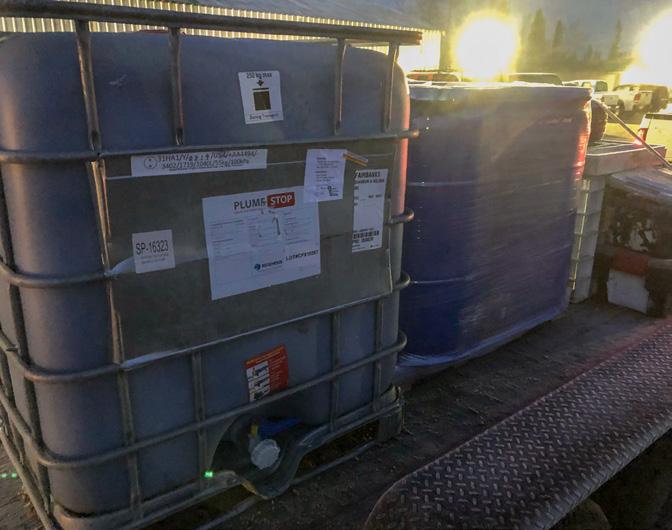
In April 2020, Bennington College published soil and groundwater testing results near a hazardous waste incin erator in Cohoes, New York. Results showed elevated PFAS levels in soil and water near a public housing complex adjacent to the incinerator. The New York Department of Environmental Conservation followed up with its own study, claiming no clear link between the incinerator's operations and PFAS.
But questions remain regarding the facility's general waste burning prac tices, which according to the New York Department of Environmental Cor rection, placed the facility on formal notice of six violations arising from its improper management of dust from air pollution control equipment and its repeated failure to control off-site fugitive dust resulting from operations. Human error and neglect are often ignored elements in the practice of dis posal methods deemed “safe”, as are the potential unintended consequences.
Another study discussed in a PFAS incineration “State of the Science Review” in 2020, found higher PFAS concentrations downwind of two Chi nese sewage sludge incinerator (SSI) facilities. The review also notes the fun damental challenge in understanding whether complete PFAS destruction has occurred.
And then there are the PICs. The mys tery surrounding the potential PICs
PlumeStop colloidal activated carbon is applied using a hydraulic percussion drill rig to remediate PFAS in-situ.
formed while burning PFAS was high lighted during a recent mass balance study, considered the first of its kind, at a wastewater treatment plant SSI in Man chester, New Hampshire.
The study, which included emissions stack testing, revealed that only 51% of the PFAS mass was destroyed via incin eration. Municipal SSIs operate at lower temperatures than hazardous waste combustors (HWCs), and higher tem peratures lead to more PFAS destruction. However, the most perplexing and con cerning finding was that 44,000 times higher fluorine levels were emitted from the stack than could be explained. The study awaits publication in a peer-re viewed science journal.
Many unresolved questions remain concerning the incineration of PFAS wastes:
• What PFAS species are present in an incoming waste stream (beyond what laboratories can currently detect)?
• What temperatures, residence times, and mixing are required to destroy PFAS (both identified and unidentified) completely?
• What are the potential PICs these facilities might generate?
• How are the PICs to be measured and analyzed?
• What are the environmental fates of the PICs?
• What are the health and environmen tal effects related to these PICs?
• Will the facilities operate according to the requirements once determined?
• Who will be affected?
Although several DOD-funded stud ies on the thermal destruction of PFAS
wastes are in progress, the questions and concerns over the burning of PFAS solid wastes will not be resolved quickly. Also, as this type of incineration must be energy intensive to be effective, the economic feasibility of the approach is in question.
The environmental cleanup of PFAS-contaminated sites will continue to increase to meet regulatory guide lines, existing and forthcoming. Unfor tunately, many groundwater recovery (i.e., pump-and-treat) systems will be employed, generating more PFAS waste products with no proven effective or safe disposal methods. Besides inciner ation, landfilling PFAS solid wastes also risks reintroducing the toxic chemicals into the environment.
Colloidal activated carbon (CAC) has been successfully applied at PFAS-con taminated sites worldwide. The patented CAC technology, from REGENESIS, fil ters PFAS from groundwater to remove human and environmental exposure risks. Treating contaminants in place eliminates the generation of PFAS waste products. Besides avoiding generat ing and disposing of wastes whose ulti mate fate cannot be assured, the use of the CAC technology to contain PFAS in place also avoids many of the financial and environmental costs of installing, operating and maintaining these pumpand-treat systems.
Injection of PlumeStop® CAC avoids these costs. CAC PFAS treatments are designed to immobilize PFAS for decades following a single applica tion. They are backed by the PlumeSh ield® performance warranty program for qualifying sites.
References available upon request. Maureen Dooley is with REGENESIS. Email: mdooley@regenesis.com
In 2020, the Region of Durham (Durham) partnered with Ontario Tech University to detect fragments (RNA and proteins) of COVID-19 in wastewater to help with surveillance and early detection of additional outbreaks of the disease.
Ontario Tech University in Oshawa is part of the Canadian Water Network’s COVID-19 coalition and the Ministry of the Environment, Conservation and Parks (MECP) Wastewater Surveillance Project. One of its goals is to support public health protection through sur veillance for COVID-19 in wastewa ter. In addition, Durham is a member of the Municipal Consortium as part of the Canadian Water Network, where the wastewater monitoring program is coor dinated within Canada and globally.
Durham staff are collecting samples from five water pollution control plants (WPCP) on Lake Ontario and two large sanitary sewage pumping stations in the Ajax/Pickering area.
Samples are collected at each WPCP’s influent sample collection point using a composite sampler. The sample rep resents a 24-hour period. These samples are analysed to assess the viral load in wastewater. When combined with pub lic health data, this information helps provide an estimate of COVID-19 infec tion trends in the community and can be useful for early detection of out breaks and surges.
Since the Omicron surge over whelmed PCR testing in Ontario, waste water monitoring has been particularly helpful for getting a sense of what’s hap pening in the community.
Graph 1 shows the seven-day average number of new cases by symptom onset date shaded in blue. The coloured lines represent statistically smoothed waste water COVID-19 viral signal for each
Graph 1. Wastewater viral signal and new cases of COVID-19 by onset date in Durham Region.

COVID-19 signal strength is shown on the left, while hospitalization numbers are shown on the right.

sampling site from November 2021 to February 2022. An increase in wastewa ter viral signal was seen across all sam pling sites in early November, almost one month before case numbers began to rapidly increase.
Surveillance of COVID-19 in waste water will continue to play an important role in public health.
Wastewater signals in all sampling locations have shown a significant increasing trend. Viral signal strength has steadily remained at high levels compared to the seasonal average since mid-June 2022. Wastewater COVID19 concentrations at all sampling sites remain above the levels previously seen
in the troughs between waves five and six, and waves six and seven.
Durham will continue its successful partnership with Ontario Tech Univer sity on a new research project “Waste water epidemiology to measure com munity gastrointestinal disease”. This project will utilize the same sample col lection sites and methodology as the COVID-19 project, but will also tar get H. pylori and cancer biomarkers in wastewater.
Tavis Nimmo and John Presta are with the Regional Municipality of Durham. Email: tavis.nimmo@durham.ca, john.presta@durham.ca






Asahi/America’s Type-21a SST Flow
Control Valve with Series 19 Smart Pack® Actuator provides a cost- effec tive, high accuracy flow control package. The characterized ball valve provides a modified equal percentage flow control, with repeatable results across span of travel. The Series 19 is capable of 0.01% accuracy of setpoint and has failsafe capability, ISO mounting configuration and NEMA 4X enclosure.
Asahi/America
T: 800-343-3618
F: 800-787-6861
E: asahi@asahi-america.com
W: www.asahi-america.com



With the FLEXFLO M3 Peristaltic Chemical Feed Pump you’ll experience quick shipping, fast install and virtually maintenance-free service, resulting in minimal downtime. The M3 delivers smooth, accurate and dependable chem ical dosing with no vapour lock and no lost prime, even when dosing peracetic acid or sodium hypochlorite. It features a large intuitive touchscreen control, advance communication protocols, and software capabilities for future firmware updates.
Blue-White Industries
T: 714-893-8529
F: 714-894-9492
E: info@blue-white.com
W: www.blue-white.com
Chemline’s V Series actuators are CSA approved. They have all the important features for municipal applications such as handwheel manual override, mechan ical travel stops, position feedback and available local control station. V Series actuators are lightweight, compact and corrosion resistant, ideal for Chemline plastic valves, ball to 6" and butterfly up to 20". WTP/WWTP applications include bulk transfer/isolation, sub-metering/distribu tion points, and chemical injection.


Chemline Plastics
T: 800-930-CHEM (2436)
E: request@chemline.com
W: www.chemline.com
The exclusive hyperdrive technology of the Multi-Diaphragm CHEM-FEED®
MD1 Chemical Metering Pump is engi neered to deliver smooth continuous chemical dosing with no vapour lock and no loss of prime, even when dosing chemicals that off-gas, such as peracetic acid and sodium hypochlorite. MD1 requires near-zero maintenance and the patented DiaFlex® diaphragm is built to last the life of the pump.

Blue-White Industries
T: 714-893-8529
F: 714-894-9492
E: info@blue-white.com
W: www.blue-white.com
The Nova is the newest generation of Boerger’s BLUEline rotary lobe pump. The rotors and the casing were created together to form a perfect partnership, and it shows. The result is a volumetric efficiency that has never been achieved before—and that’s not all! What’s most exciting is that smooth pumping is main tained even at high pressures.
Boerger
T: 612-435-7300
E: america@boerger.com
W: www.boerger.com
Large diameter work being done? Time is money and with Denso Mastic Blankets as part of your Denso corrosion preven tion system, you can get the job done right, more efficiently. At 10" x 39", the mastic blankets cover a large area, filling voids and profiling in seconds. Protect your assets and save time and money with the Denso Petrolatum System. Denso North America
T: 416-291-3435
E: sales@densona-ca.com
W: www.densona.com
Endress+Hauser’s Micropilot FWR30 revolutionizes level measurement of liquids and solids. It is the world’s first wireless 80GHz IIoT sensor, that unites high-end measurement technology and user-friendly digital services in one economical device. Its continuously recorded measurement data can be accessed at any time, from anywhere, via the sensor’s cloud connection, providing users with facts where previ ously only assumptions were possible.

Endress+Hauser Canada
T: 800-668-3199
F: 905-681-9444
E: anam.akbani@endress.com
W: www.ca.endress.com
SXblue SMART is a rugged and versatile

Multi-Frequency GNSS RTK Receiver with built-in IMU tilt sensor. It can provide accuracy down to centime tres in RTK mode. RTK mode requires a pair of receivers: one is stationary which provides corrections; the other is moving which applies corrections and provides its precise coordinates. The SXblue SMART GPS receiver can ensure centimetre accuracy in real time. Since the receiver supports Galileo, BDS(Bei dou),GPS, Glonass, SBAS, IRNSS and QZSS satellite constellations, it can provide a high level of GNSS accuracy, even in harsh conditions.
GENEQ
T: 800-463-4363
E: info@geneq.com
W: www.geneq.com or www.geneqonline.com
Stop a chlorine leak within seconds of detection by automatically closing the ton container or cylinder valve. The actuator quickly mounts to valve without the use of any tools, and still allows the valve to be manually opened or closed. Halogen Valve Systems are the only systems that confirm that the valve was torqued closed to the institute recommended standard.


Halogen Valve Systems
T: 949-261-5030
W: www.halogenvalve.com
The Wizard 4000™ advanced multi-channel indicator monitors any chemical in your treatment plant. Using our scales or ultrasonic sensors with your tanks and cylinders, the Wizard will display amount remaining, amount used, daily used, feed rate, days until empty and other critical data. Outputs include 4-20mA, MODBUS serial communication and control and alarm relays.
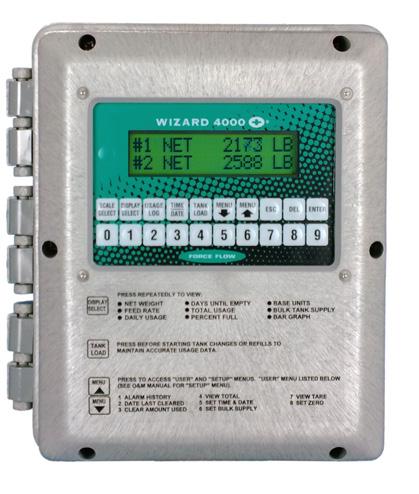
Force Flow
T: 925-893-6723
F: 925-686-6713
E: info@forceflow.com
W: www.forceflowscales.com
SolarBee® mixers leverage solar power to provide effective circulation from all areas of a lake, reservoir or pond. They are designed to operate 24/7/365, using digital logic for onboard battery management and have an auto-re verse/anti-jam feature. Active mixing a reservoir controls odour, eliminates cyanobacteria (blue-green algae) and improves biological processes. A single unit treats up to 35 acres.

Greatario
T: 866-299-3009
E: info@greatario.com
W: www.greatario.com/greatwater
Harmsco’s WaterGuard™ Water Filtration System provides a “Whole House” water purification device that combines multi ple filtration technologies in one filtra tion unit. First level is a 5 micron sediment filter followed by an activated carbon filter which will remove chlorine and PFOS/ PFAS. Then, the water enters a UV steril ization chamber that inactivates viruses, bacteria, cryptosporidium and giardia. Harmsco Filtration Products
T: 800-327-3248
E: sales@harmsco.com
W: www.harmsco.com
The LittaTrap Catch Basin Insert is a low-cost, innovative technology that prevents plastic and trash from reaching our waterways. Designed to be easily retrofitted into new and existing storm water drains, the LittaTrap is installed inside storm drains and when it rains, catches plastic and trash before it can reach our streams, rivers and oceans.

Imbrium Systems
T: 800-565-4801
E: info@imbriumsystems.com
W: www.imbriumsystems.com
NETZSCH’s maintenance-friendly Full Service-in-Place (FSIP®) NEMO® progressive cavity pump has a large inspection cover. Open the pump cavity on-site, dismantle all rotating parts and replace them without removing the pump from the pipe assembly. Capaci ties and pressures are equal to the same size classic NEMO progressing cavity pump – known for continuous, pres sure-stable, gentle and low-pulsation conveyance of almost any substance.

NETZSCH Canada
T: 705-797-8426
F: 705-797-8427
E: ntc@netzsch.com
W: www.netzsch.com
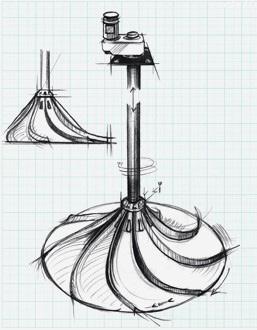
Invent Environment is the manufac turer of hyperboloid mixers which have revolutionized anoxic and swing zone mixing. Invent provides low-shear, efficient mixers with no submerged motors or gear boxes for easy access for maintenance. They have now released the Hyperclassic Mixer Evo 7 which has increased the number of motion fins and adjusted the geometry of the mixer to maximize mixer efficiency, reducing operation costs even further.
The new Stormceptor® EF is an oil grit separator (OGS)/hydrodynamic separator that effectively targets sedi ment (TSS), free oils, gross pollutants and other pollutants that attach to particles, such as nutrients and metals. The Stormceptor EF has been verified through the ISO 14034 Environmental Management – Environmental Technol ogy Verification (ETV).
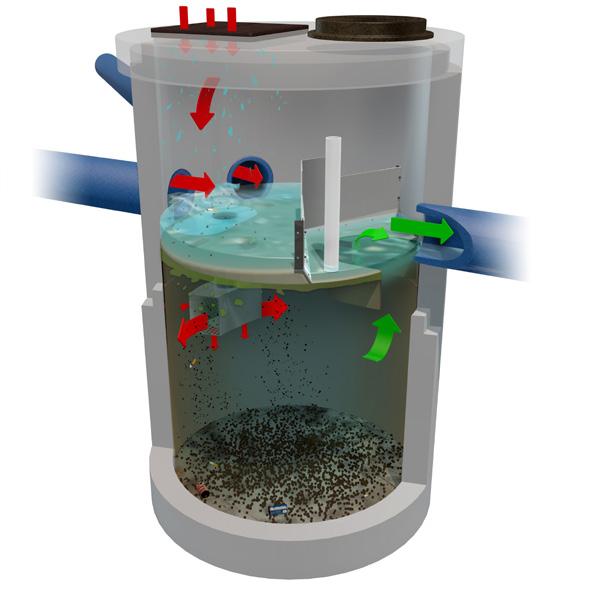
Imbrium Systems
T: 800-565-4801
E: info@imbriumsystems.com
W: www.imbriumsystems.com
Huber, a proven German manufacturer, now provides watertight doors that allow safe access to tanks for construction and/ or maintenance. Doors can be provided as round or rectangular for installation onto existing concrete surfaces or cast-inplace in new concrete. They can handle heads up to 30 m and hold pressure in seating and unseating directions. Huber’s watertight doors can greatly reduce construction and maintenance costs and dramatically improve safety/access.


With Rapid Assessment Technology Services (RATS Inc.), municipalities focus their high-cost resources on the small percentage of their network that represents a potential service disruption or hazard to the community. With patented acoustic technology, we inspect approxi mately 3,000 metres of 150-450 mm grav ity sewer lines per day – all at a fraction of the cost of the old CCTV methods.
Assessment Technology Services (RATS Inc.)



University of Lethbridge researchers have been given $1.5 million to study Alberta’s Frank Lake wetland over five years.



This restored wetland is designated as a protected area for birds that is man aged by Ducks Unlimited Canada. It also helps remove nutrients, salts and chemicals from the Town of High River and animal feed company Cargill Lim ited’s treated effluent, which is released into Frank Lake to maintain water levels.
watershed as best as possible.”
Ducks Unlimited Canada began working at Frank Lake in 1952. Despite the group’s efforts, sustained droughts caused the lake to go dry by the 1980s.

When her father, a commercial fisher man, was finding it more and more diffi cult to ply his trade due to harmful algal blooms, Annabelle Rayson decided it was time to fight blooms in the Great Lakes.
Now, the Sarnia, Ontario, highschooler is the proud recipient of the Stockholm Junior Water Prize for her research, which examined biomanipulation and the species of zooplankton best suited to prevent algal blooms.
Rayson’s project compared different genotypes of Daphnia magna, a small planktonic crustacean, for algae con sumption. There were five experiments in all. She said that the most effective genotype was then tested under different environmental conditions to see which factors helped or hindered harmful algae bloom treatment and prevention.
Rayson ultimately discovered that genotype 4 was the ideal genotype of Daphnia magna for treating blooms. “It can produce significant algae decreases in all of the different algae combinations,” Rayson wrote in her research paper, not ing that it can even be effective in plas tic-polluted environments.
Ecological health can be improved through calcium carbonate and naturally occurring aquatic microbes, she found. “Clones exposed to nutrient pollution had equal average algae decreases to the controls, which were significant average algae decreases of 94%,” she wrote.

To better understand the elements of how wetlands help to treat wastewater,

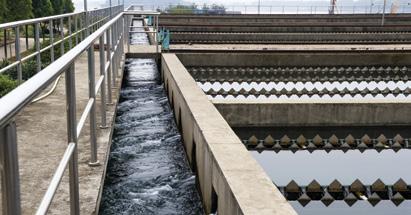
The concern for stakeholders is how long the wetland can sustain current lev els of treatment, and whether actions can be taken to enhance its functioning. “The goal of this project is to understand the impacts of land use on the health of the Little Bow watershed, with a focus on the role that the Frank Lake wetland plays in processing effluent in this economically important region,” said Matthew Bog ard, an assistant professor of biology and Canada Research Chair at the University of Lethbridge, in a statement. “We want to provide all stakeholders with scientific knowledge and data to help manage the
“The answer to stabilizing Frank Lake came in 1988 when we joined forces with industry and municipal, provincial and federal governments to secure a longterm water supply for the lake,” Ducks Unlimited Canada explains in a descrip tion of its work in Alberta. “A pipeline was installed to divert water from the Highwood River, and a series of dikes and water control structures were added to restore the lake to its former water levels.”
Cargill Limited and the Natural Sci ences and Engineering Research Coun cil (NSERC) of Canada Alliance pro gram are co-funding the study, which will examine nutrient cycling in the watershed, water quality, aquatic ecol ogy, health of the wetland and surround ing vegetation, as well as effluent toxicity.


 HRH Crown Princess Victoria of Sweden presents Annabelle Rayson with the Stockholm Junior Water Prize. Credit: The Stockholm International Water Institute
HRH Crown Princess Victoria of Sweden presents Annabelle Rayson with the Stockholm Junior Water Prize. Credit: The Stockholm International Water Institute
A team of U.S. researchers has deter mined that a number of COVID-19 related treatment medications do per sist in wastewater, but more work needs to be done to understand the potential impact on aquatic life.
The Pennsylvania State University researchers found COVID-19 patient treatment medications, such as remde sivir, dexamethasone and antibiotics for associated bacterial infections, when sampling influent and effluent from two wastewater treatment plants in central Pennsylvania between May 2020 and
May 2021. One of the sites had a hospital in its service area.
Among the antibiotics tested, the team found that the concentrations of the antibiotic trimethoprim could pose a low-to-medium risk to aquatic life, while sulfamethoxazole, also an antibi otic, could pose a high risk, specifically to algae, which is a food source for many organisms.
“While the concentrations we calcu lated considered the individual risks that each drug could pose on aquatic life, these calculations do not account for the potential risks that could come from the synergistic effects of these drugs in a mixture, which could be much higher,”
stated Heather Preisendanz, associ ate professor of agricultural and bio logical engineering at Penn State, in an announcement.
“Importantly, our study highlights the opportunity that wastewater surveil lance provides to understand the effects of human health on water quality and ecological health,” she added.

The research team found that remde sivir concentrations were correlated with the number of hospitalized COVID-19 patients, while dexamethasone concen trations were associated with the number of hospitalized patients on ventilators. These medications treat severe upper respiratory inflammation in patients on ventilators.
Specifically, influent to the wastewa ter treatment plant servicing the hos pital had concentrations of remdesivir and dexamethasone of 28% and 31%, respectively, while the average removal efficiencies by the wastewater treatment plant for these drugs were 39% and 56%, respectively.


A new study out of Australia’s Griffith University has found that a 20% decrease in wind speed from climate change could result in algal blooms almost oneand-a-half times their current size.
Using a 3D hydrodynamic model to simulate the movement of water in a lake, researchers were able to determine that less wind reduces mixing in the water column in lakes and other bodies of water, allowing buoyant cyanobacteria to float to the surface and form blooms.
Lead author Mohammad Hassan Ranjbar, a PhD candidate at the Austra lian Rivers Institute, said that the impact of less wind on algal blooms is more than six times that of a 2°C increase in air temperature associated with climate change. While a 2°C increase in air tem perature increased simulated mean col ony size by 5%, the study found in sim ulations that less wind speed increased simulated mean colony size by 38%.
research is the first to demon strate that atmospheric stilling along with increasing air temperature can favour
blooms of these buoyant, colony-form ing cyanobacteria,” Ranjbar said in an announcement from Griffith University.
Co-author Professor David Hamilton, acting director of the Australian Rivers Institute, said the research shows that “wind speed needs to be included in any projections looking at changes in the frequency, distribution and magnitude of algal blooms under climate change.”
Turbulence, light, temperature, and nutrients in the water column of a shal low urban lake can also impact the size of algal blooms, the study states.
“Trends in observed terrestrial near-sur face wind speed show that atmospheric stilling is widespread worldwide,” the study’s conclusion states. “If this trend continues, especially in combination with rising temperatures and increasing loads of nutrients, there may be a substantial increase in the frequency and extent of cyanobacteria blooms globally, suggest ing that water resource managers should consider the increased risk of cyano bacterial blooms under a warmer and calmer future climate.”
A Calgary-based firm with expertise in water project management, Westhoff Engineering Resources Inc., has been acquired by CIMA+, one of Canada’s largest privately-owned consulting engi neering firms.
Founded in 1996, Westhoff comes with a multidisciplinary team of engi neers and biologists. Led by founder and chief engineer, Dennis Westhoff, the company’s strategy has been to turn water and environmental constraints into opportunities through the applica tion of holistic approaches to stormwa ter management, including wetland and stormwater integration.
CIMA+ has more than 2,800 employ ees across some 30 offices in Canada.
ACG-Envirocan Inc. announced their appointment as the exclusive manufac turer’s representative and distributor for SSI Aeration in Ontario.
BW Space Pro is now available for underwater inspections. This intelligent underwater drone camera integrates both underwater shooting and observa tional functions. It has a five hour bat tery life, four thruster drive and can dive as deep as 100 metres.
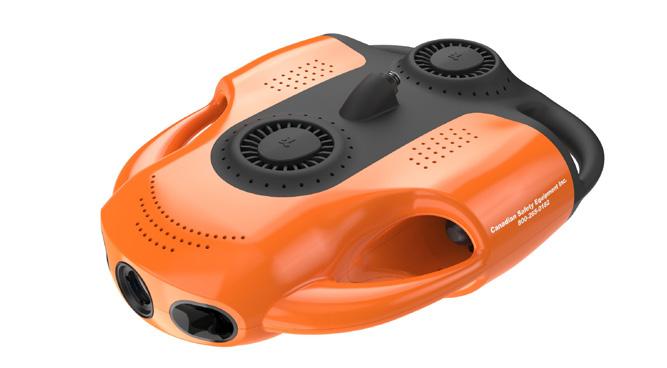
It is easily maneuvered via remote control, is capable of 360-degree free rotation, calculates depth automatically, indicates temperature and provides realtime transmission of underwater pic tures and video.
The BW Space Pro is equipped with two hi intensity LED lights and is avail able with an optional 6X zoom.
For more information, visit: www.cdnsafety.com
Founded in 1995 in Poughkeepsie, New York, SSI produced its first fine bubble diffusers in 1997. Since then the company has specialized in the rapid advancement of secondary biological wastewater treatment through research and development.
The results include patented advanced fine bubble diffuser membrane materi als, innovative product fabrication tech niques, and innovative and simple inter locking parts.
For more than 40 years, ACG-En virocan has been in the industrial and municipal wastewater, stormwater and potable water treatment equipment business.

For more information, visit: www.acg-envirocan.ca

Ontario’s York Region is celebrating a new award that recognizes the innovative microtunnelling tech nology used for its Sewage System Forcemain Twinning Project. The Peter J. Marshall Innovation Award was pre sented to York Region in August at the 2022 Association of Municipalities of Ontario (AMO) Conference in Ottawa.
One of the primary reasons for the award was the York-Durham project’s lack of disruption to the public and envi ronment through the use of tunnelling. According to environmental services firm GHD, the project’s lead designer, the tunnelling allowed teams to work up to 20 hours per day, reducing a proj ect that could have taken several years, down to just 18 months.
The technology was used to tunnel seven different stretches for a total of 5.6 kilometres, making it one of the lon gest microtunnelling projects in Cana da’s history. Crews used an unmanned, laser-guided boring machine controlled remotely by an aboveground operator.
“Using state-of-the-art, record-setting microtunnelling design and construc tion, York Region was able to minimize impacts to the community and natu ral environment, all while tunnelling through busy streets, trails and even crossing rivers,” announced York Region Chairman and CEO Wayne Emmerson, in response to the award.
Tunnelling also allowed local leaders to preserve the Holland River floodplain, which cuts through the heart of York as well as minimizing road and land access closures, and the need for excavating and backfilling.
overall purpose of the project was to provide
for aging infra structure, improve system reliability and reduce environmental risk. Work
Pre-stressed cylinder pipe segments were used within the precast tunnel sections for the purposes of constructing the new forcemain within the tunnel.

GHD
move wastewater from the Newmarket Pumping Station to the Aurora Pump ing Station.
Additionally, crews built a new twinned forcemain to move wastewater from the Bogart Creek Pumping Station to the newly-constructed York Durham Sewage System forcemain.
“By twinning the forcemain, we were able to build system resiliency, reduce greenhouse gasses and maintain essen tial water and wastewater services for the more than 1.2 million residents who call York Region home,” said Emmerson.
According to GHD, pre-stressed cyl inder pipe segments were used within the precast tunnel sections for the pur poses of constructing the new forcemain within the tunnel.
“While pre-stressed cylinder pipe seg ments are not new to forcemain con struction, the placement and connec tion of pre-stressed cylinder pipe seg ments within the extremely long tunnel section posed a unique challenge,” GHD states in its project description.
accomplished these goals through building
twinned forcemain to
Infrastructure Canada supported the project by providing $48 million in funding through the Disaster Mitiga tion and Adaptation Fund, recognizing the project’s role in addressing climate change risks.




